

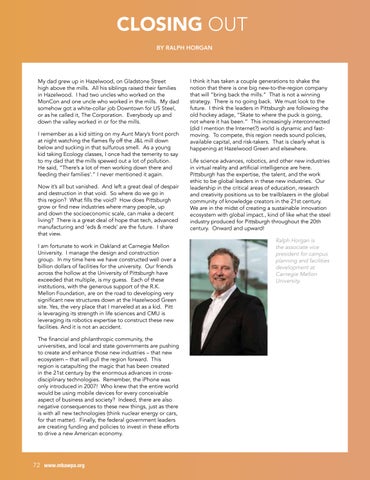





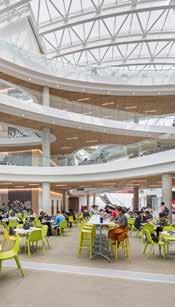


CONTRIBUTING PHOTOGRAPHY
AE7 Architects
JMilteer Photography IKM Inc.
Mascaro Construction Master Builders’ Association of Western PA Ed Massery Photography
NAIOP Pittsburgh Shell Chemicals Piatt Companies Craig Thompson Photography UPMC Adam Warner
ADVERTISING DIRECTOR
Karen Kukish 412-837-6971 kkukish@talltimbergroup.com
MORE INFORMATION:
BreakingGroundTM is published by Tall Timber Group for the Master Builders’ Association of Western Pennsylvania, 412-922-3912 or www.mbawpa.org
Archive copies of BreakingGroundTM can be viewed at www.mbawpa.org
No part of this magazine may be reproduced without written permission by the Publisher. All rights reserved.
This information is carefully gathered and compiled in such a manner as to ensure maximum accuracy. We cannot, and do not, guarantee either the correctness of all information furnished nor the complete absence of errors and omissions. Hence, responsibility for same neither can be, nor is, assumed.
Keep up with regional construction and real estate events at www.buildingpittsburgh.com








We take pains to be accurate here at the Tall Timber Group. For as long as I have been working, it was always made clear to me that what I do and say may be a source of disagreement, but if I were accurate in reporting the work it could stand up to disagreement (and criticism). So, it is with some trepidation that I must begin the January/February edition of BreakingGround with the disclaimer that the feature article is most likely full of inaccuracy.
The upside of that admission is that it will be five years before anyone can tell how inaccurate we will have been.
January is when we run our “Big Picture” edition each year. Since 2007, we have tried to use the first edition of the year to highlight a trend or market condition that seems to have broad impact. As 2023 begins, the Pittsburgh construction market has mostly shrugged off the effects of the pandemic and appears to be able to shrug off the effects of the supply chain disruption and inflation that resulted from the pandemic in the coming year. Assuming that is true, the path forward for the next couple of years is pretty clear. Backlogs are high for the most part. The course of the major projects in the region is set. What is not clear is what will come after this wave of work is built. What will drive construction in Pittsburgh – and elsewhere – in the latter half of the decade?
We can start answering that question from the perspective that we do not know today what will drive construction in five or seven years. There were plenty of smart people willing to share their thoughts and the result is pretty good. The chances that what all these smart people predicted will come to fruition are 50/50 at best.
There are some overarching trends that will influence what and how much is built by 2030, for which there is little that can be changed. Declining college enrollments or rising healthcare costs, for example, will impact capital spending in those sectors; however, neither of those is a regional problem. The same might be said about the demographic trends in Western PA, but that is not strictly true. Or at least the demographics of 2030 are not inevitable.
Demographics are vitally important to our region. The aging of Pittsburgh has been a driver of construction, but also an impediment. The fact that our population is not growing limits how much existing Pittsburgh businesses can grow. It stands as an obstacle to business attraction because it raises doubts about a new business’s ability to attract workers. And it stands as a significant threat to the growth and buildout of the emerging technologies that are being developed in Pittsburgh. It is great that the talent and technology exists to make Pittsburgh an R & D center for robotics, AI, immunology, and other cutting-edge technologies. It will not be great if all that cutting-edge R & D results in creating a gazillion jobs in some other city or state that has figured out how to compete for talent and business better than Pennsylvania has.
The problem boils down to two, mostly related, solutions. More people (ideally younger ones) need to move to Western PA to replace the people who are retiring and dying; and incentives for that to occur need to be created. It is obvious that many young people have moved to Pittsburgh in the past decade. Do we know why? Do we know why so many more moved to Austin or Nashville? (Weather? Music? Barbeque?) Are we being honest with ourselves about what it is that Pittsburgh has to offer?
I spent the 1980s in the south, working in the Carolinas, Atlanta, Texas, and Louisiana. The economy was not always booming but people moved there in droves because there were so many job opportunities, or at least the perception of job opportunities. If employers in Pittsburgh have the job opportunities but not the applicants, shouldn’t that be creating the incentive for people to be moving here too? Granted, the weather is better in the south and southwest, but is that enough of a difference? There is a theory out there that people no longer have to move for jobs, but that doesn’t seem to be how things are working out in Austin, Nashville, Houston, or even Tulsa, OK.
As you will read in the feature, the forecast for Pittsburgh’s population by the end of the decade is not inspiring. That forecast need not become the reality. There clearly is potential for amazing new business growth brewing in the research being done across many fields in Pittsburgh. It is also clear that without sufficient population, that potential may become reality elsewhere.
My concern is that this is one of those problems that the unnamed “they” should be solving. There are resources being applied to business attraction, workforce development, a more equitable economy, and a host of other problems. Without enough people, however, the solutions to those problems will not matter in 2030. If there is not a population attraction committee working somewhere (and I have not heard of one), perhaps one should get cracking. It is time to get laser-focused on how to solve the problem of getting people to move here. Put some AI on the case. Do things that haven’t been tried before. Do things that growing cities are doing. Do whatever gets the job done.
The problems that the emerging technologies are aiming to solve in Pittsburgh are real and the solutions will make some people rich and create thousands and thousands of jobs. It would be a shame for most of those jobs to go elsewhere. There are plenty of other competitive issues that the regional and state leaders need to address but solving the population problem is paramount. Make it job one.
Pittsburgh Works Together advocates for an all-inclusive economic future that recognizes the vital role of both traditional and emerging industries.

Data from the end of the third quarter paints an optimistic picture of the regional economy in Pittsburgh, one that is improving at a better clip than in the U.S. overall. Unlike during the recovery from the Great Recession, when the Marcellus shale play pulled Pittsburgh out of recession faster than all but two other cities, the current business cycle has reverted to what would be expected from a region without population growth.
From 30,000 feet, it appears that the lack of population growth and unfavorable demographics have been a drag on the Pittsburgh economy so that its recovery has lagged the national rebound from the pandemic. According to the Southwestern Pennsylvania Quarterly Vitals report from the Pennsylvania Economy League, slower growth in the workforce has led to slower job growth from September 2021 to September 2022. The report showed labor force growth of 0.9 percent year-over-year in the seven-county Pittsburgh metropolitan statistical area. That compared with 1.9 percent growth nationwide and 1.6 percent growth in the benchmark cities used to compare Pittsburgh. Job growth in Pittsburgh was 2.8 percent from October 2021 to October 2022, compared with 3.7 percent nationwide and 3.9 percent in benchmark cities.
There are, however, indications that the recovery is continuing in Western PA, while the economy elsewhere is slowing. The unemployment rate in Pittsburgh is higher than the U.S. rate, at 4.1 percent, but declined more steeply compared to October 2021. At the end of October, there were only 40,000 unemployed persons in metropolitan Pittsburgh, fewer than in February 2020. Moreover, there were significantly more jobs posted for hire in Pittsburgh – 27.9 percent more than the year before – suggesting that employers continued to see demand for growth at a much higher rate than their counterparts in other parts of the U.S.

The shortfall in job recovery from September 2019 to September 2022 reveals that Pittsburgh has fallen below the rest of the U.S. in a few significant categories, generally professions where older workers have retired faster than average. The most significant variance is in educational services, where employment in Pittsburgh is at 84.3 percent of the September 2019 levels, while the U.S. overall is at 102.9 percent of the September 2019 level. Recovery in construction employment is 10 percentage points lower than in the rest of the U.S., 92.2 percent versus 102.3 percent. In both education and construction, demand for employment is as high or higher than in 2019 but the workforce has contracted.
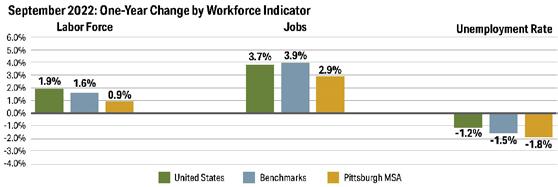
An economic slowdown in the U.S. in 2023 would certainly reduce some of the demand for employment and services in Pittsburgh but, as was the case in 2011-2013, there can be regional factors that keep demand for construction higher than in the rest of the country. The outlook for 2023 suggests that demand for construction will vary significantly from sector to sector.
Construction of commercial real estate properties will see lower volume in 2023. The higher cost of borrowing money, and greater reluctance to lend, is making development and acquisition less desirable at this point in the cycle. Conditions vary among the major commercial property types.

The trials of the office market have been well chronicled (including in BreakingGround, November/December 2022). According to Pittsburgh’s major real estate service companies, the office market in Western PA softened throughout the first three quarters of 2022 and is slowing. Vacancy in both Class A properties and the overall market is above 20 percent. Capitalization rates for office properties have pushed higher by 200 basis points or more, making financing and exit strategies more difficult.
In addition to the soft market conditions, there is significant uncertainty about the return to office, both in the near term and in the post-COVID 19 market. While office occupancy on Mondays and Fridays appears to be stuck below 25 percent, the
SPONSORED BY:New construction of industrial properties continued at a high level and deliveries of new product pushed absorption slightly into negative territory. Source: Newmark.
number of workers returning to the office regularly in midweek has steadily, if slowly, increased to nearly 50 percent. Few observers expect these levels to remain this low as 2023 and 2024 unfold; however, the outlook for new construction is weak. One potential bright spot for office construction is an uptick in tenant improvements as more companies take advantage of the more competitive market to move to new space when their leases expire.
Industrial construction is also likely to see lower activity in 2023. Through three quarters of 2022, the market fundamentals were driven by a heightened level of new construction, particularly in the Class A sector. Roughly 1.8 million square feet of new Class A industrial space was under construction in October, and almost 400,000 square feet of space had been delivered since spring. That pushed the vacancy rate for Class A space up from 2.3 percent to 4.2 percent. Along with two previously occupied buildings becoming available, the new deliveries created 1.7 million square feet of Class A space ready to rent. That is a luxury in a market that has seen almost no inventory of Class A space available in a decade.
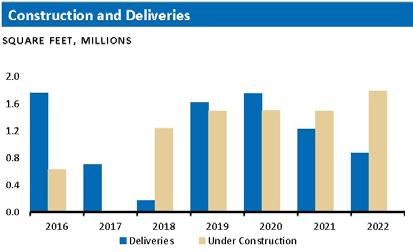
Overall industrial vacancies edged up from 5.5 percent to 6.0 percent in the third quarter. Net absorption of space remained at one million square feet, helping to keep rents above $7 per square foot on average. More of the absorbed space was Class B than Class A, which Newmark reported had not occurred in several years.
Looking forward, the slowdown in expansion by Amazon has cooled demand for large distribution and third-party logistics (3PL) space, although the Pittsburgh market will likely not feel the slowdown as much as markets with major 3PL hubs. Industrial brokers from Genfor Real Estate, JLL, CBRE, and Newmark reported that there have been leases renewed for the existing 3PL tenants in Pittsburgh, but there were not as many new inquiries for logistics space.
The slowdown in the economy has also reached the apartment market. According to Apartment List’s report on rents, the median rental rate in Pittsburgh declined at twice the rate of the national median rent in November. That marked the largest monthly decline since 2017 and the third consecutive monthly decline. Rents were down in 93 of the nation’s 100 largest cities in October. Some of the regional highlights from the report were:
• Rents in Pittsburgh decreased 2.0 percent month-overmonth in November.

• Year-over-year rent growth in Pittsburgh currently stands at 1.8 percent, compared to 12.7 percent at this time last year.
• Median rents in Pittsburgh currently stand at $1,003 for a 1-bedroom apartment and $1,222 for a two-bedroom. The potential for recession tends to slow the formation of new households, which eases the upward pressure on rents. That easing is underway and comes as new multi-family construction reaches multi-decade highs. However, none of this should have a remarkable impact on the pipeline of apartments in Pittsburgh. First, the difference between a hot and cold market in Pittsburgh is 500-750 units. Second, the lag between construction and availability is typically 12-to-18 months. Today’s pipeline won’t be ready to rent until 2024 or later. The most notable impact of a decline in rents will be on lenders and investors, who may prefer other assets with less short-term risk of decline. Investors in Pittsburgh’s apartment market tend to look longer term, but an extended slowdown
Source: Southwestern Pennsylvania Quarterly Vitals, Pennsylvania Economy League.
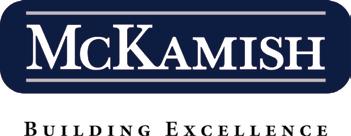
Average apartment rents have fallen since July in Pittsburgh. Source: Apartment List.

in rent growth (or decline) could put projects that are being designed on hold.
Even accounting for the softening conditions, the Pittsburgh Homebuilding Report forecasts 1,800 apartment units starting in 2023.
The Downtown apartment market is bucking the trends for rents and construction. The Golden Triangle market has rebounded to pre-pandemic levels, with the occupancy rate climbing from 86.1 percent in the second quarter of 2021 to 91.9 percent in the third quarter of 2022. The jump in occupancy came as nearly 900 new units were added to the inventory Downtown during the past 15 months. At the end of 2022, there were 972 units in the announced pipeline of new apartments in the Golden Triangle, including 300 units of new construction at the City Club Apartments, which PJ Dick expects to get underway in 2023.
Unlike commercial real estate, institutional construction is poised for a boom, although the activity will be mainly focused on major projects.

Hospital construction will see the most volume in 2023, as the $1.2 billion UPMC Heart and Transplant Hospital gets underway in earnest. Construction of the new bed tower, along with the UPMC Vision and Rehabilitation Tower at UPMC Mercy, will mean fewer other significant construction projects for UPMC in 2023, although construction should also begin on the $45 million UPMC Children’s Hospital Heart Institute. Planning will continue for Allegheny Health Network’s proposed $400 million cardiovascular tower at Allegheny General Hospital and new Canonsburg Hospital, as well as Excela/Butler’s plans for a new patient tower at Greensburg Hospital and the $100 million Eye Institute at West Virginia University Medical.
The construction boom in higher education, which runs contrary to national trends, should be in full swing in 2023. Construction is underway or about to begin on three major projects at University of Pittsburgh, the $100 million Central Utility Plant, the $154 million Student Recreation Center,
and the $190 million Arena and Sports Performance Center. Construction is also to begin on the $100 million Pitt BioForge project in Hazelwood Green, which was recently awarded to Turner Construction. Two of Carnegie Mellon University’s major projects should start work in 2023. Mosites-Gilbane should begin construction on the $75 million Robotics Innovation Center at Hazelwood Green in the third quarter. The $275 million R.K. Mellon Science Center will now also be home to the School of Computer Science and the College of Fine Arts and the PJ Dick-Mascaro team is expected to start before the end of 2023. And Pittsburgh Planning Commission recently approved Radnor Property Group’s proposed 12-story, $70 million residence hall for Duquesne University on Forbes Avenue.
Public construction will likewise be driven by a handful of major projects, as opposed to increased investment across the sector. Although most of the major contracts have been awarded on the airport’s $1.4 billion Terminal Modernization Program, another $400 million in prime contracts remain to bid. The K-12 market continues to be underfunded; however, three K-12 projects in the $100 million range should bid next spring: the new Quaker Valley High School; the Hempfield Area High School; and the Bethel Park Elementary School.
Infrastructure construction should be increased compared to the past few years, as the funds from CARES Act, the bipartisan infrastructure legislation, and the Inflation Reduction Act make their way into the capital spending at PennDOT and the Turnpike Commission, as well as hundreds of municipalities that have under invested for an extended period. Construction will get underway in the first quarter of 2023 on the region’s biggest infrastructure project, the $291 million Bus Rapid Transit system. Bids have been taken on the $25 million Downtown Loop and stations, which will be the first piece of the system built. Construction on the Uptown and Oakland sections will not begin until 2024.
Business conditions for the construction industry coming into 2023 are roughly 180 degrees from the conditions at the start of 2021. Contractors have built solid backlogs, but most have seen disappointing financial performance in 2022 because of the significant delays and deferrals of work in the backlog. Higher costs and supply chain disruption remain sources of delays and frustration, but the outlook for improvement in those conditions is favorable. It is unlikely that there will be a snap back to pre-pandemic “normal” in 2023, but rather a gradual decline in the headwinds facing the industry and region. Should those headwinds become tailwinds, construction volume in 2023 has the potential to reach the record high set in 2021. BG


Almost across all industries and geographic markets, 2022 was a disappointing year for business. The persistent high level of inflation softened demand for products and services as the year unfolded. Central bank monetary policy tightened to the point of becoming restrictive to growth and, indeed, gross domestic product (GDP) declined in the first and second quarter. However, neither consumers nor businesses reacted to higher interest rates with the kind of pullback that shocked the U.S. economy into recession. The lingering question that remains from 2022 then is whether recession looms for 2023.
With inflation showing signs of easing as 2022 ended, there is more of an opening for the Federal Reserve Bank to pause rate hikes and allow disinflation to play out. But, with the job market remaining as tight as during periods of peak employment, the Fed has more incentive to push the envelope until unemployment begins to rise. The consensus in the markets is that the target range for Fed Funds will reach 5.0 to 5.25 percent before rate hikes cease, likely not until the May meeting.
So, will 2023 bring recession? The year ahead will bring decisions from consumers, employers, and policy makers that will balance restraint (or retrenchment) against the desire for growth. The trade-off of spending versus saving, hiring versus downsizing, and tightening versus easing will determine whether or not the U.S. economy contracts.
The signal that is the strongest indicator of a coming recession is a change in consumer spending. Despite countless anecdotes of how inflation is squeezing household finances, personal consumption remained strong through 2022. The source of that strength, at least in part, was the extreme jump in personal savings in 2020 and 2021. Shutdowns and government largesse combined to allow consumers to save an average of nearly 19 percent of their disposable income from March 2020 to March 2021 (compared to an average 7.5 percent since 2000). That led to household savings of roughly $13.8 trillion. More than $1 trillion of that buffer was depleted in 2022 through October. Following a record holiday splurge, consumer savings will be at pre-pandemic levels in January 2023. Absent that cushion, and with inflation still outpacing wage gains, consumers may be forced to tighten their belts through the first half of 2023.
One reliable – if not irrefutable – indicator of an impending recession is the inverted yield curve.
Such an inversion, in which the interest rate of short-term bonds exceeds that of long-term bonds, suggests that investors are hedging concerns about the health of the economy by buying short-term U.S. Treasury debt. In midDecember, the 3-year Treasury was yielding between 3.8 and 4.1 percent (compared to 0.87 percent a year ago), while the 10-year note was yielding 3.5 percent (compared to 1.6 percent a year ago). An inversion of six months, such as is
Savings deposited in U.S. financial institutions declined by nearly $1 trillion since March 2022. Source: Federal Reserve Bank.

A comparison of data used by NBER to judge whether or not the economy is in recession is still showing expansion. Sources: Bureau of Economic Analysis, Bureau of Labor Statistics, Federal Reserve Bank, National Bureau of Economic Research.



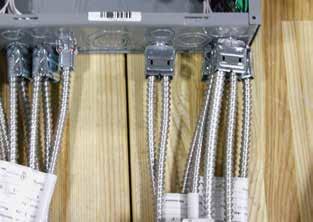
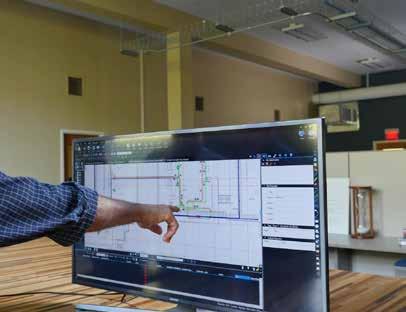


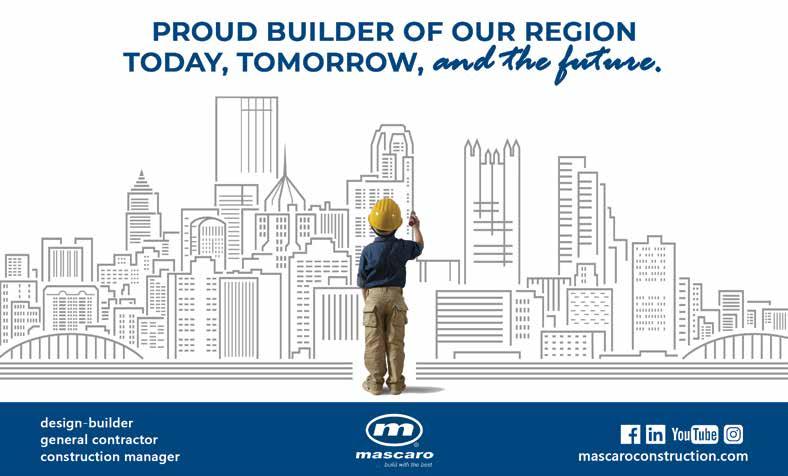
currently the case, foretells a recession six to 12 months later.
While many media outlets jumped on the two consecutive quarters of negative GDP to declare recession, the National Bureau of Economic Research (NBER) – the private, nonprofit founded to make such a declaration official – did not. NBER takes declining GDP into account, but also looks at a variety of other economic metrics to determine whether a recession is, or has, occurred. None of those metrics have turned negative since the end of 2021, let alone approached the declines associated with a median post-1950 recession. In fact, two of those measures, payroll employment and industrial production, have been well above the GDP trend, growing by 2.7 percent and 3.4 percent respectively. Moreover, the GDP growth rate for the third quarter rose to 2.9 percent, nearly a full point above expectations.
Another recession indicator that arose as a result of research done by Claudia Sahm, an economist formerly with the Federal Reserve and the Council of Economic Advisors, finds that a recession occurs when the three-month moving average for unemployment rate moves 0.5 points above the low mark for the previous 12 months. Using the so-called Sahm Rule, unemployment will have to climb above four percent before recessionary conditions occur.
As 2023 begins, the inverted yield curve anticipates recession soon. The Sahm Rule indicates that unemployment has another 50 basis points of room to move. And the NBER has few, if any, metrics to suggest that a recession looms. The conflicting signals create a dilemma for policy makers.
For the Fed, the dilemma is compounded by the fact that its actions take 12 months to bring results. With each monthly report that shows inflation remaining persistent, even if the rate of inflation slows, it is difficult to entertain the idea reducing or pausing rate hikes. Thus, the current restrictive path the Fed has taken will be followed until signs of recession appear. A slowdown in hiring or a significant increase in
unemployment would be such signs; however, in every business cycle over the past 40 years, the unemployment rate did not begin to tick upwards until after the Fed stopped raising rates. That makes the unemployment rate a poor leading indicator.
Into December, when the reports on November’s inflation showed significant cooling from mid-summer highs, unemployment remained low, and more than 10 million job openings remained unfilled. The sources of inflation were narrowed primarily to the services and shelter sectors. Those sectors remained near double-digit inflation rates; however, it is worth noting that each is a lagging indicator that requires a tighter job market to drive prices lower. Apartment leases renew each month, so only 10 percent or so of the shelter prices are subject to current market forces. Service prices trend closely with wages. Until more people are losing jobs, both sectors will see elevated prices year-over-year.

As the fourth quarter began, the labor market was decelerating. Through the first half of 2022, employers averaged 444,000 new hires each month. From September through November, that rate slowed to 262,000, the slowest since the start of 2021. Responses from employers in the Fed’s Beige Book indicate that hiring plans are diminished for 2023. That would bring job gains down further or lead to losses that would bring some relief to the monetary tightening. And there was significant anecdotal evidence of layoffs. Amazon announced plans to lay off 10,000 workers the week before Thanksgiving. Meta told investors that it was cutting its staff by 13 percent, or by more than 11,000 employees, in response to poor results. Morgan Stanley cut its global staff by two percent in December.
There are additional signs that the economy is cooling in ways that would relieve inflation. Shipping giant, Maersk, reported that its expectations are for a slowdown in activity in 2023. The Drewry World Container Index had fallen 40 consecutive weeks by Thanksgiving and shipping rates were more than 70 percent lower than the peak in September 2021. At the end of November, the backlog of ships waiting offshore to access the Los Angeles/Long Beach port was zero, down from a high of 110 in January 2022.
Indicators of a global recession are much stronger than those pointing to a recession in the U.S. Unlike the past few cycles, central banks have been well coordinated in their efforts to squash inflation. But, for most other regions of the world – including the European Union, Great Britain, and emerging economies – the monetary squeeze of higher borrowing costs began when their economies were much weaker. To compete against U.S. Treasury bonds and avoid weakening their own currencies, other countries have raised interest rates in step with the Fed. That has meant crippling economic growth in most of the rest of the world. A steep global recession would deflate price escalation and allow the
Both billings and inquiries have softened for architects since the end of summer.Fed to reverse its rate hikes in the second half of 2023. Such a recession would also bring economic pain to the U.S. consumer.
The impact of a slowing economy has begun to show up in the construction market data. Construction spending remains near all-time high levels because of high double-digit inflation but has leveled since summer 2022. The latest reading by the Census Bureaus showed total spending at $1.795 trillion in October, down 1.3 percent from the July 2022 peak. Total nonresidential spending was 9.8 percent higher than October 2021, roughly 10 percentage points lower than the year-over-year rate of inflation for nonresidential building.

Housing starts continued a year-long decline. From a peak of 1.8 million units in May, housing starts have fallen to a 1.4-million-unit pace. Construction of single-family homes has slowed more than the overall housing market. In part, this is because the quick, sharp rise in mortgage rates had a more immediate impact on buying decisions for homeowners. Conversely, the longer lead time for multifamily development means that apartment construction lags behind single-family in responding to market disruptions like rate hikes. Through October, developers were on pace to build 70,000 more units in 2022 than in 2021. That pace is expected to cool in 2023, although demand for rentals remains strong.
Construction spending has begun to decline from cyclical highs, even with double-digit inflation. Source: U.S. Census Bureau.
A leading indicator that has softened since the end of summer is the American Institute of Architects’ (AIA) Architectural Billings Index (ABI). A monthly survey of AIA member firms, the ABI reflect the direction of billings, new project inquiries, and design contracts. Readings above 50 indicate more firms are seeing increases than decreases. Because architectural services lead construction by as much as 12 months, the ABI is an accurate indicator of construction activity in the coming year.
Through summer, ABI had been solidly positive, a trend that stretched back to February 2021. Inquiries had been increasing in six of 10 firms for most of 2022. Beginning in September, however, all three indicators of architectural demand weakened, with billings falling to 46.6 in November. Backlogs at architectural firms remain strong, at roughly seven months; however, if the current trend holds, construction will be slower by mid-year 2023. The countervailing pressure to the slowing trend is the unusually high number of projects previously designed but not released for construction due to higher inflation and economic uncertainty. A mid-2023 shift in perception about the economy or in construction costs would boost construction ahead of a reversal of trend in architectural activity. The indicators from architects, absent such a shift, suggests that construction will slow over the coming year.
The results from the mid-term elections should be neutral to the construction market. The flipping of the majority in the House of Representatives means a divided government,
something that is generally viewed as favorable for business. Republican control of the House is tenuous, which should protect against dramatic changes in direction. At the same time, a Republican House of Representatives is less likely to pass legislation that increases government spending on construction significantly. Public construction will not get a boost from a divided government, but private construction should not see further regulation. And the major federal legislation to boost infrastructure, power, and manufacturing projects during the 117th Congress will be slow to turn into construction contracts because of regulatory hurdles and the “buy American” restrictions of the law.
Perhaps the best indication of how much or how little construction will rebound in 2023 will come from the path of inflation. If the easing of inflation evidenced in the fall of 2022 turns to falling prices in the first quarter, owners and developers will have more confidence that their projects will not suffer from unforeseen cost increases. That will be especially true if the economic data continues to show that higher interest rates are leading to a soft landing, rather than a demand-crushing recession.
The coming months present an opportunity for a turning point in the direction of the U.S. economy. The March Federal Open Markets Committee (FOMC) meeting will be the first for which the rate hike expectation is not baked in (assuming the February hike of 25 basis points occurs). March’s meeting will be the first opportunity to pause rate hikes, action that the Fed has been reluctant to take. Winter will have ended in Europe, and with it will come an opportunity to see energy prices fall. That would significantly ease inflation overall. By the time the FOMC meets and acts in March, the U.S. should have a good idea about whether a soft landing or recession is in the cards for 2023 BG





Aslowing economy and restrictive Federal Reserve Bank monetary policy are bringing the pace of inflation lower, according to the most recent reports from the Commerce Department. Consumer prices (CPI) were 7.7 percent higher in November 2022 than November 2021, a decline from the 7.9 percent pace of September. Core CPI – stripped of energy and food prices – was 6.3 percent higher year-over-year, lower than the 6.6 percent clip a month earlier.
This evidence of disinflation was encouraging news for policymakers. The impact of slowing inflation has yet to be felt significantly in construction, although there were several optimistic shifts in trend.
November’s data showed a five-percentage point drop from the September peak in the producer price index (PPI) for new nonresidential buildings, from 24.1 to 19.8 percent year-overyear. That is likely the result of the lagged response of contractors’ bid prices during the month. Contractors have typically raised bid prices 12 months or so after material input prices escalate. A similar lag occurs when input prices fall. Input prices peaked in June 2021 and began to decline in March 2022. Similarly, the price squeeze on contractors – the period in which the increase in input costs exceeds the increase in bid prices – typically lasts two years. In the current cycle, the reversal in November followed a 19-month squeeze.
The Bureaus of Labor Statistics November report on producer prices confirmed that peak of input and bid price inflation has likely passed. Moreover, November’s report showed that more inputs were declining month-to-month (although most were still higher than the year before by double-digits), meaning that the input escalation was confined to a few notable categories.
Among these were flat glass (up 12.0 percent), cement (up 12.9 percent year-over-year), gypsum products (up 18.0 percent), architectural coatings (up 26.3 percent), and #2 diesel (up 59.6 percent).
Diesel’s impact is, unfortunately, multiplied throughout the construction supply chain. Diesel is an oil derivative, as are asphalt, roofing, lubricants, and plastics. Diesel is the primary fuel used in construction equipment and in transportation, of which construction is a heavy consumer. Unlike in the winter of 2022, there are currently reasons for optimism about the price of diesel and oil. The European Union is enduring
a difficult winter without consuming Russian oil and gas, but the end of winter, and potentially the war in Ukraine, means that supplies of oil will be higher. The slower global economy will demand less oil and gas. While the West cannot expect the politics of the major suppliers of oil to change and increase production, the constraints on demand should lead to lower prices.
Among the construction materials seeing major declines in prices, steel (down 26.6 percent), copper (down 7.8 percent), aluminum (down 12.7 percent), and lumber (down 5.8 percent) fell the furthest. BG

The phrase “end of an era” tends to be overused. As often as not, the phrase has been used to emphasize the impact of a changing of the guard in a sports context, like when Michael Jordan retired the first and second time or, closer to home, when Ben Roethlisberger hung up his cleats.

The $500 million Esplanade will develop in multiple phases during the rest of the decade.

Historians and economists are generally less dramatic than sportswriters, but there are times when it is appropriate to declare that an era has ended. When World War II ended, America eclipsed Europe as the driving force of global events. In the mid-1980s, when heavy manufacturing ceased in Western PA, the course of daily life changed dramatically in dozens of towns. And, in the middle of this decade, a few construction projects will wrap up that could mark a generational change in construction in Western PA. Whether the construction industry remains on its current robust trajectory from 2025 to 2030 is an open question.
By that time, construction will have been booming in Pittsburgh for two decades. When the regional economy recovered fully from the 2001 recession, construction began on an extended string of major projects and heightened demand that will culminate in the construction of four billiondollar projects. With the Shell Monaca Polymer project completed, work on ALCOSAN’s expansion, the airport’s Terminal Modernization Program, and the UPMC Heart and Transplant Hospital will carry on through 2025. In the two decades since 2005, construction provided full employment, and generally experienced a shortage of workers. Dozens of contractors saw their revenues top $100 million. There were always big projects on the horizon.

In 2025, that horizon will look emptier than it has since the
Plan B construction boom of the late 1990s. Since the late 1990s, three major sports venues, a convention center, and new airport have been built, and a massive expansion of the region’s main treatment plant has been undertaken. There are not a lot of mega public investments left for this generation to make. The construction industry will rely upon the private sector of the economy to drive demand for services in the latter half of the decade.
That is not the worst-case scenario. Private commercial development played an outsized role in construction during the 2010s. New industries have emerged – and are emerging – to create employment and demand for space. Pittsburgh’s economy is forward-looking, with many prospects for opportunities. Unlike in 1990, when the construction industry needed a major infusion of public projects to create demand, it is plausible that private industry will provide significant new construction opportunities. The question is, how much opportunity?
There are macroeconomic trends that will have an influence on construction demand heading into the next decade that will also be felt in Pittsburgh. Associated General Contractors’ chief economist, Kenneth Simonson, outlined eight of these factors (see page 27) in his outlook presentation for 2023.
Among the global/national trends that are most likely to track similarly in Pittsburgh are a declining birth rate that will suppress demand, a continued shift in retail to e-commerce, more specialized and online healthcare, lower demographic support for higher education, and increased construction of facilities for alternative energy production.

Among these, the decline or stagnation of Pittsburgh’s metropolitan population is the most significant to demand creation in 2025-2030. Simonson spoke of the declining birth rate suppressing demand for goods and services and, therefore, facilities. For Pittsburgh, the lack of population growth is less a suppressor of goods and services than it is a drag on economic development. Companies looking to locate in Western PA will see the stagnant population as a risk to finding workers. Those companies that are in Pittsburgh will find it harder to grow in a region where the workforce is not growing. While this has been a problem in Pittsburgh for more than 30 years, the challenge of attracting population will be greater in the coming decade.
“A big challenge we’re going to be facing is that a lot of the population issues we’ve been dealing with over the past several decades are now becoming more of a nationwide phenomenon,” says Jim Futrell, vice president of research for the Allegheny Conference on Economic Development, “The population is aging nationwide, and the birth rate is
declining. Legal immigration is still at a trickle. We are not feeding the population base. Pittsburgh will be competing with a lot more regions for population.”
One sector that will feel the population squeeze most directly is the residential market. Absent an influx in new residents, the demand for new homes and apartments will remain muted. Construction of new multi-family units saw an uptick in 2013 that will endure into the middle of the decade; however, the level of construction in the Pittsburgh multi-family market is relatively low. Its “boom” years have seen less than 3,000 units and the 10-year average since 2013 is 2,125 units, a good month’s worth in Atlanta or Austin. Apartment demand in Pittsburgh has been propped up somewhat by the low inventory of homes for sale since the end of the Great Recession. Should that fundamental condition change, demand for apartments would likely fall, even if the current trend of a growing younger demographic cohort continues.
It is the demographic trends that offer the best hope for a shift in demand in the housing market. Builders added about 4,000 new single-family homes each year in Pittsburgh from 1985-2005, but the average volume has fallen by nearly 1,000 homes annually since then. One of Pittsburgh’s defining demographic trends – its aging population – should be creating a dynamic home market, with empty-nester Baby Boomers selling more homes than there are buyers. Since
For more than a decade, DFL Legal has provided companies with the most effective solutions in resolving unique construction and engineering disputes.



Our success has been achieved by offering our clients proven, big case experience, along with the efficiencies and flexibility of a boutique firm.
Find out how our experience can be put to work for you.

These are the hallmarks the region’s union construction trades and contractors bring to the jobsite everyday. Our professional tradespeople and contractors bring the dreams and visions of our fast-growing region to life with a dedication that only those who live here, work here, and raise their families here can commit to. It is, after all, our home, our legacy.
We are also committed to providing opportunity for all who share these values and want to pursue a lifelong, lucrative and satisfying career. For more information on building with our union trades and contractors, or to explore career opportunities, please visit www.buildersguild.org where you will find direct links to our Trade Unions, Joint Apprenticeship Training Centers and Contractor Associations.
the early 2010s, however, homeowners have been staying in their family homes much longer than in previous generations. It is possible – maybe even expected – that this trend will reverse in the latter half of the decade when Boomers begin to reach their 80s. Residential developers are unlikely to risk millions of dollars in anticipation of that reversal. New home construction is likelier to be a lagging indicator of a population change than a leading one.
The drivers of demand for construction in the latter half of the decade are more likely to come from the job-creating sectors, like emerging technologies, healthcare, education, and manufacturing.
Five years ago, as construction at Shell Chemical’s polymer plant was gearing up to the billion-dollar-plus construction level each year, the outlook for manufacturing construction was bullish. Given the decades-long buzz about new technologies, it was surprising that the expansion of chemical, steel, and natural gas-related manufacturing was spurring billions in investment. Since 2017, however, markets have changed.
Manufacturing is not dead as a potential driver of new development, but its impact has been delayed by weakness globally. By the middle of the decade, however, the business cycle could be more favorable.
Natural gas extraction and processing is a political football; however, its commercial viability has improved as its price has risen over the past two years. At the end of the year the price of natural gas had fallen from its mid-year highs but, at $4.50 per million cubic feet, was a dollar or more higher
JLL ranked Pittsburgh 11th among U.S. cities for investment and development of life science research and applications.

than in the salad days of the Marcellus shale buildout in the early 2010s. The potential for downstream development still exists, whether in petrochemicals or in more refined applications like hydrogen production. PTT is rumored to be in negotiations with a partner or buyer for its Dilles Bottom site, increasing the possibility that a second cracker could be under construction by the second half of the decade. And the gas processing infrastructure that was developed in Western PA during the 2010s will require hundreds of millions in capital expenditures for maintenance and modernization.
Supply chain onshoring was predicted to be a beneficial trend that resulted from the disruption caused by the pandemic. While a wave of new projects has yet to swamp the U.S. or Western PA, the supply chain adjustments made by most industries have resulted in construction of more domestic warehouse space. Manufacturing has also seen an increase in the U.S. as suppliers have added incrementally to what is produced closer to their customers. On a limited basis, some industries have invested large sums to bring key manufacturing operations back home. The $10 billion Intel plant being built outside Columbus, OH is an example of such an investment.
Advanced manufacturing should also see an incremental buildup throughout the decade. Research and development, both at the university and private sector levels, has grown and the commercialization of new technology has increased. Neighborhood 91, adjacent to Pittsburgh International Airport, is an example of how the breakthroughs in advanced manufacturing can translate directly to new construction.
While manufacturing has the potential to be a resurgent
construction driver by 2025, the more likely sources of booming development in the latter half of the decade are the emerging technologies that have become the foundation of the Pittsburgh economy over the past 20 years. If construction comes from tech, it is more likely to be the result of sustained innovation than a new technology that takes off. Pittsburgh has seen the lightning-in-a-bottle innovation flare brightly and then fade in the recent past (FORE Systems, Uber, etc.). The “next big thing” can drive construction on a limited basis, but the flare out of that next big thing dampens momentum for talent and venture capital accumulation.
The good news in 2023 is that there has been the kind of steady innovation that builds long-term momentum in several industry clusters.

Robotics and autonomy were in the news quite prominently in 2022. The surprise shutdown of vertical farming company, Fifth Season (formerly Robotany), and the unsurprising decision by Ford and Volkswagen to discontinue funding Argo AI at levels that could sustain its operations were reminders that some emerging technology companies will not survive. One month earlier, however, there was rather good news for the sector when the U.S. Department of Commerce announced that southwestern PA was a winner in the Build Back Better Challenge.
A coalition of robotics and autonomy industry players, civic
and government leaders, elected officials, and academics submitted a response to the challenge under the name of the Southwestern Pennsylvania New Economy Collaborative. In September, the Pittsburgh group learned it had been awarded $62.7 million to help implement five projects aimed at upskilling workers, providing capital and technical assistance, and supporting small-to-medium-sized companies in the industry sector. The focus of the Southwestern Pennsylvania New Economy Collaborative is on equitable growth of robotics and autonomy, so its expectations are that the projects will grow the workforce; however, its projects are forecasted to add more than 1,000 jobs and retain almost 1,200 others.
Robotics/autonomy as a sector is projected to see job growth of 6.5 percent annually. For Pittsburgh, that would mean the employment in robotics and autonomy would double by 2030, to 12,600 jobs. Considering that this sector generates indirect employment at a rate of better than one-to-one, there should be demand for an additional 1.2 million square feet to house the employment base by 2030. Should additional manufacturing and testing space accompany that growth –not a sure thing by any means – that demand would grow substantially.
At the end of 2022, Pittsburgh ranked seventh in autonomous businesses establishment and trailed only Detroit/Ann Arbor for market leader locations. For the most part, Pittsburgh is a
research and development center for robotics and autonomy, but its position as one of the global centers for the sector increases the chances for expansion. Such an expansion along the rivers in Lawrenceville – in the so-called Robotics Row area – and in Hazelwood Green, where Advance Robotics for Manufacturing is located in Mill 19 and Carnegie Mellon plans to build its $75 million Robotics Innovation Center in 2023. Expansion from commercialization of research and development in artificial intelligence is likely to be less concentrated, according to Steve Guy, president and CEO of Oxford Development Company.
“Artificial intelligence is one industry that I think is going to
be spread out in terms of how they manage their people. I think the hundred thousand square foot user will be the exception. There will be more 20,000 and 30,000 square foot centers,” Guy predicts. “That said, there are so many applications coming off AI technology that the volume of these companies may be far more significant. Those companies have huge investments in personnel for project management and coding. That’s their capital spend. And I think it will be very significant.”

Life sciences may represent the most lasting opportunity to be a sustainable driver of development in Pittsburgh. The confluence of information technology and healthcare innovation that exists in Pittsburgh (primarily within a ten-block area in Oakland) is occurring in a region with demographics that are supportive of growing healthcare demand. Pittsburgh is older than most cities. It is home to world-class medical research and treatment for cancer and blindness. There is a history here of medical breakthroughs and advancements in vaccines and transplants.
In its 2022 Life Sciences Research and Cluster Rankings report, JLL measured the key factors supportive to life science innovation and developed a composite score that weighed talent (35 percent), funding (30 percent), and commercial real estate (35 percent). Pittsburgh ranked 11th in the U.S.

In its findings, JLL found that the strength of the universities and the growth momentum for key talent were pluses for Pittsburgh; however, JLL cited the shallow talent pool, lower venture capital investment, and limited lab infrastructure as drags on the ranking.
It is the latter factor, although currently a negative, that represents significant opportunity for high-quality development and construction, particularly if the talent pool and capital investment made in Pittsburgh continues to improve. Even with stagnant population growth, Pittsburgh has seen an average employment growth of seven percent annually since 2020 in this sector. That rate is expected to accelerate in the latter half of the decade.
In Pittsburgh, continued growth in employment and innovation in these sectors is what is expected to drive new construction later this decade. For University of Pittsburgh, the idea of being a “partner and anchor” for private sector development – as it described the university’s role in its latest Institutional Master Plan – would drive infill construction along Forbes and Fifth. The Murland Building, Walnut Capital’s Innovation Tower, and the proposed 3440 Forbes Avenue life science tower Turner Construction will build for Wexford Science + Technology are examples of how the private sector can assemble older, low-rise properties along this innovation corridor and replace them with larger, denser facilities for research and development.
“I’m still bullish on the tech sector. We have a lot of opportunity to grow. It’s not just robotics. It’s artificial intelligence, companies like Google, Apple, Facebook,” says Walnut Capital’s president, Todd Reidbord. “The other sector that makes me bullish is life sciences. I think the combination of Pitt and UPMC is a sleeping giant because they have such great academic research. It has not yet translated very well to the corporations. When you look at what is being done in Philadelphia or San Diego in life sciences, we have the same – or better – infrastructure in terms of universities and medical centers but we just haven’t taken advantage of it yet.”
If this portion of an innovation corridor unfolds as desired, developers will be building several million square feet of research, office, labs, residential, hospitality, and street-level retail. In other cities construction of these kinds of districts tend to accelerate in pace as the concept is proven. Even if that does not occur in Pittsburgh by 2030, the current pace of demand suggests that another three to five new buildings will be built along Forbes and Fifth in the latter half of the decade.
What could create a booming level of demand for millions of square feet of high-end space? It was the long-term vision of Pitt’s Chancellor Mark Nordenberg and Carnegie Mellon’s Jared Cohon that the health and life sciences prowess of the former would combine with the information technology prowess of the latter to accelerate the region’s economic growth when they announced the Regional Economic

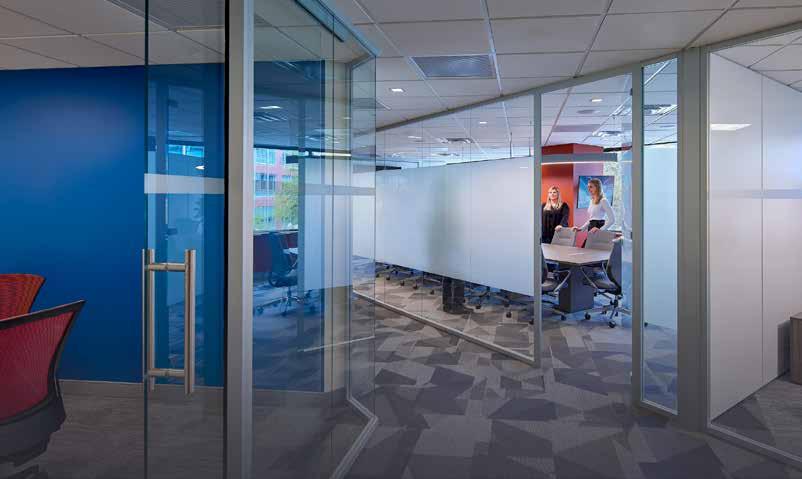


Development Project in 2002. CMU President Subra Suresh articulated the potential for that collaboration when he described the ForbesFifth corridor between the two universities as an innovation corridor that would flourish. That collaboration has yet to reach its potential in 2023, but it exists as a powerful opportunity that would drive demand for facilities.
“With what the two universities bring to the table, that collaboration would be a market edge for Pittsburgh that could rival what we see around John Hopkins or Washington University,” predicts Bob Reppe, assistant vice president and university architect at Carnegie Mellon University (CMU). “If we can figure out how to get the two institutions to the table on the right projects, the result could be that game changer people are looking for.”
“The whole Fifth-Forbes corridor is for us an opportunity to advance our aspirations towards supporting translational work in the life sciences. We’re also interested in seeing the densification of commercial and retail space to support the neighborhood,” says David DeJong, senior vice chancellor for business and operations at University of Pittsburgh.
The strength of Pittsburgh’s higher education construction market runs counter to the prevailing trend nationally. Universities have been struggling with declining enrollments since the late 2010s due to higher tuition costs, a shift in the overall view of the necessity of a college degree, and fewer young people of college age. The latter demographic trend becomes a cliff in the middle of the decade. But, while the landscape will be challenging for colleges and universities nationwide, those institutions perceived to be in the top 50 or 100 are expected to flourish. It is Pittsburgh’s good fortune to have two such institutions, which have campuses that now cross boundaries.
Healthcare, as a construction sector, has arguably been the driver of the most construction volume over the past decade. The region’s two largest health systems, UPMC and Allegheny Health Network (AHN) have spent roughly $400 million annually on renovations, expansion, and maintenance throughout their systems, much of it in Western PA. St. Clair Hospital completed a $100 million-plus expansion. And UPMC and AHN built both new hospitals and outpatient facilities throughout Southwestern PA.
The extended capital investment in


followed

the new reimbursement landscape under the Affordable Care Act (ACA). While there is no similar legislative or regulatory headwind like the ACA today, the next few years are expected to see leaner capital spending as healthcare reassesses a changing post-pandemic landscape.
“In the year and a half since vaccines have been available, we have seen our volume recover but it is still lower than it was before the pandemic, on an inpatient basis,” says Roger Altmeyer, vice president of project development and construction at UPMC. “We don’t know if that is because people are still concerned about coming to the hospital, but inpatient volumes are low industry wide. When we look at development in the future, the trend continues to be towards outpatient services. There continues to be more that we can do on an outpatient basis, so we expect there to be more facilities in the communities, rather than in a large urban hospital.”
“The healthcare industry continues to grapple with cost containment as the federal government continues to clamp down on reimbursements. There is and will be a continual site of care shifting and regulators will continue to push more acute treatments to an outpatient setting,” predicts John Schrott, president of IKM Inc., an architectural firm with an extensive healthcare practice. “That means those outpatient procedures will be different from today’s outpatient procedures because those patients will need to recover for a longer period. Outpatient centers we have now will need to be modified to accommodate these ‘23-hour’ patients.”

Schrott expects to see joint replacements, interventional cardiology, and bariatric procedures become largely outpatient. The role of the large urban hospital will be to care for the patients with the most acute illnesses. That transition in function will create construction opportunities.

“There will have to be renovations at the larger, older hospitals to make those facilities better suited to handle patients with more acute conditions,” Schrott says. “The second half of this decade will be interesting as we see less utilization of tertiary care facilities, more utilization of outpatient facilities, and the further advancement of technology in our normal healthcare treatment and diagnosis.”

CMU has been on a building binge for more than a decade, adding eight new buildings for classrooms, research, and residential use, along with doing major additions on several others.

www.hrg-inc.com


By 2025, construction will be winding down or completed on its two newest buildings, the $260 million R. K. Mellon Science Center and the $75 million Robotics Innovation Center. Reppe says that there are other new buildings on CMU’s master plan, but a period of reevaluation is likely to follow the current burst of construction.
“We have a lot of capital maintenance to do on our legacy buildings, especially on our 100-yearold Hornbostel buildings. They need a complete code update,” he explains. “Another thing that we frankly don’t know the answer to is what to do with the existing Mellon Institute after the completion of the R.K. Mellon Building. How do we position the Mellon Institute for the future? Is it more science? Is it a mix of science and other disciplines? That’s a problem we’ll have to be solving in the next five to eight years.”
A third priority CMU will address is student housing. Three new student residence buildings – two of them new construction - have been completed as a first phase. Reppe explains that a second phase of housing is planned for the latter half of the decade that will require demolition of existing residences.

“We are looking to densify student housing, bringing an existing facility down and replacing it with something denser,” he says. “The Greek quad is a great example. It has 80 beds per acre where everything that we have built lately is 300 to 350 beds per acre.”
“Those are the three big things. Of course, there is always the potential for the next graduate who makes a billion dollars in an IPO to come back with a gift, saying that we need a new building” Reppe laughs.
A few blocks away, University of Pittsburgh is underway with the first wave of its $1 billion capital plan. Four building projects of more than $100 million each – Scaife Hall expansion, the new Student Recreation and Wellness Center, the Arena and Sports Performance Center, and a new central plant – have begun and a re-working of the improvements to Bigelow Boulevard has been completed. Those projects should carry on into the middle of the decade. The current wave of major construction projects underway and in design are fulfilling the master plan goal of enriching the student experience. In the queue between now and 2025 are two major residence facilities, the $150 million Hillside Residence Hall to be built adjacent to the Student Rec Center, and the $140 million Mid-Campus Residence Hall to be built south of Sennott Square along Bouquet Street.

Construction on ALCOSAN’s $1.5 billion plant modernization and expansion will continue in phases through the middle of the decade.

As the campus adjusts to the chaos of those major projects – plus UPMC’s new hospital – a change in leadership is underway, which will coincide with an evaluation of what parts of Pitt’s ambitious master plan will come next. It should come as no surprise that will include a focus on the sciences. Key to the next phase of the master plan is an ambitious expansion and connection of its main east-west academic corridor, centered at Crabtree Hall, that would integrate the university’s main science facilities with UPMC’s new flagship hospital.
“The Crabtree redevelopment is absolutely critical as a nexus for us. It’s not just how we interface with the hospital but, if you look at Pitt in isolation, below Crabtree all of our STEM activities are concentrated very tightly,” explains DeJong. “If you pivot on that building, you have all the life sciences right there. Crabtree Hall is just a critical nexus of all of that. We are looking at that as an opportunity to intensify the already tight synergies that we have. We see it as an opportunity to densify what is there.”
Much of UPMC’s major capital plans are taking a back seat to the efforts needed to get its 900,000 square foot Heart and Transplant Hospital underway. The tower, which will replace UPMC Presbyterian University Hospital as the system’s flagship, advanced to construction during a period of unusual cost escalation and supply chain disruption. The Heart and Transplant Hospital at UPMC Presbyterian will be under construction into 2026, wrapping up at roughly the same time as the airport Terminal Modernization Program.
As the bed tower is winding down, construction should be getting underway on the third major project UPMC announced in 2018, the UPMC Shadyside/ Hillman Cancer Center expansion; however, Altmeyer notes that the schedule for UPMC Shadyside has not been set.
“Our investment in the [Heart and Transplant Hospital] requires a great deal of planning and attention,” says Altmeyer. “We are concerned that the programs we are putting there are done right, that we have the right number of beds. Until we have completed that process, most of our attention will be focused on the [Heart and Transplant Hospital]. The leadership at Presby is the same leadership at Shadyside. I don’t expect that we will resume planning on Shadyside until 2025.”
When construction ends on the Heart and Transplant Hospital at UPMC Presbyterian, UPMC plans additional investment in Oakland. Its current institutional master plan (which will expire during the construction of the Heart and Transplant Hospital) includes a 200,000 square foot, nine-story addition to Western Psychiatric Institute and Clinic, a project that should cost in the neighborhood of $250 million. UPMC will also have to consider what to do with the existing Presbyterian University Hospital, which occupies most of a full block of very valuable Oakland real estate, and whether to restart significant expansion projects at Children’s Hospital and UPMC East. Altmeyer says that an update to the master plan will be deferred as long as possible while the impact of the new flagship hospital is evaluated.
UPMC has historically invested $250-to-$300 million in capital expenditures to expand, upgrade, and maintain its facilities. That investment has generally occurred separate from major projects like the Vision and Rehabilitation Hospital at UPMC Mercy or the Heart and Transplant Hospital. Altmeyer reports that UPMC continues to invest in its facilities but explains that the impact will differ.
“Remember that we are statewide now. We have hospitals in five different regions throughout Pennsylvania. We will continue to spend that, or more, but those capital investments will be made across a bigger footprint,” Altmeyer says. “Most of our facilities are also older so we have to invest more in infrastructure and maintenance to keep the facilities operating.”
Allegheny Health Network invested roughly half a billion dollars during the first half of the decade building new facilities that brough healthcare to the suburban communities and created its own world-class cancer institute at its Allegheny General Hospital. AHN is continuing that community-focused expansion with the construction of a new $150 hospital in the Canonsburg area. In the second half of the decade, however, the focus of its major capital spending may be at its urban campuses.
At Allegheny General Hospital, a $300-400 million cardiovascular tower, to be located above the existing Cancer Institute and Sandusky Street Garage, has been in the early planning stages since the late 2010s. At AHN West Penn Hospital, the master plan calls for a 350,000 square foot medical office and outpatient facility to be built, along with a 700-car parking garage.

When asked to make predictions about activity in the latter half of the 2020s, commercial real estate brokers joked that they were uncertain about the market for 2023, let alone five years hence. The pandemic changed our work and shopping habits, altering the office and industrial markets dramatically. Going into 2023 with commercial mortgage rates at or above seven percent, developers are treading water until borrowing and construction costs cool. For Pittsburgh’s commercial real
estate market there are a few guesses about what will be moving in five-to-eight years.
“What will drive demand, in office at least, is having this touchdown or clubhouse space. We need attractive space so that it’s not a mandate to get people into the office but a magnet to draw them in,” says Bill Hunt, president and CEO of The Elmhurst Group. “I hope the answer to regaining balance is not a lot of new supply. I think we developers have to start thinking about how we can improve the existing pie rather than expanding the pie. In the aggregate I don’t know that we need more space.”
“The suburban markets are a question mark for me. The businesses that are there tend to have lots of floor plate and may not have the need for that space with technology, remote work, and artificial intelligence advances that are coming,” says Steve Guy. “I think you will see more tech companies in the suburbs for tech flex on the light industrial side but not large office users. Cargo and supply chain will continue to be served heavily on the industrial side. There is so much opportunity in that market.”
Large scale commercial development is not gone for the remainder of the decade, however uncertain the conditions may be.
On the north shore of the Ohio River, just west of the Rivers Casino, The Piatt Companies are nearing the start of work on the Esplanade, a mixed-use development of 1.7 million square feet. The project has attracted attention because of some of its unusual recreational features, a splash park, aquarium, and 175-foot Ferris Wheel among them, but the heart of the development will be hundreds of multi-family units, a hotel, and 300,000 square feet of medical/tech/life sciences space.
The $236 million first phase of Esplanade, which will include 300 apartments, a 550-car garage, and marina, should see site work begin by 2024, with construction carrying on in multiple phases through 2028.
Walnut Capital, which began construction of its Bakery Square redevelopment during the Great Recession, expects to start work on its Oakland Crossings development by 2024. That project includes roughly 1,000 units of residential with retail – including a grocery store – and extensive green space. Reidbord says his firm also has plans to expand significantly at Bakery Square.
“We acquired adjacent properties and control 34 acres that present development opportunities for current Bakery Square tenants to expand or to develop for new tenants who want to be near Google and other tech tenants,” says Reidbord.
The potential for the economic growth that would support new construction from 2025 to 2030 is not without the potential for problems. The reform of the commonwealth’s corporate net income tax rate that passed last year is a positive move but is a small step towards making Pennsylvania competitive. The regulatory environment, especially on the environmental and municipal entitlement levels, discourages developers. The potential expansion of robotics, autonomy, and advanced manufacturing, if realized, would all require construction of large facilities of the type that have bogged down in municipal planning and zoning offices, and the Department of Environment Protection. There will need to be more barriers to competition removed to see the full construction potential of the next wave realized BG
Industry leadership from the region’s largest locally-owned accounting firm.


When it comes to your business, we look at the big picture. And we never forget the importance of a personal relationship. With our wide range of accounting, tax and advisory services, you can count on us to deliver day after day.
To learn more, visit www.schneiderdowns.com/construction

Gennaro J. DiBello, CPA gdibello@schneiderdowns.com
Ted M. Pettko, CPA tpettko@schneiderdowns.com
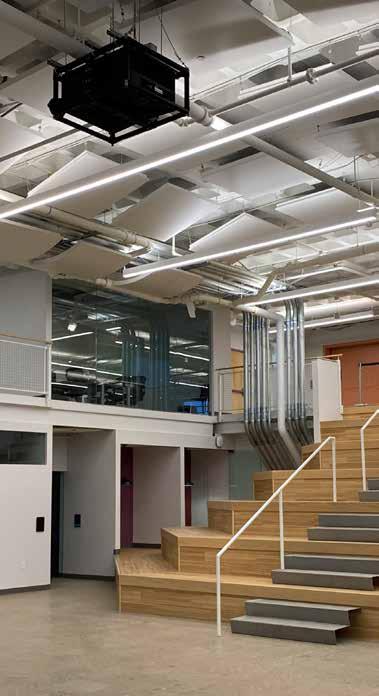

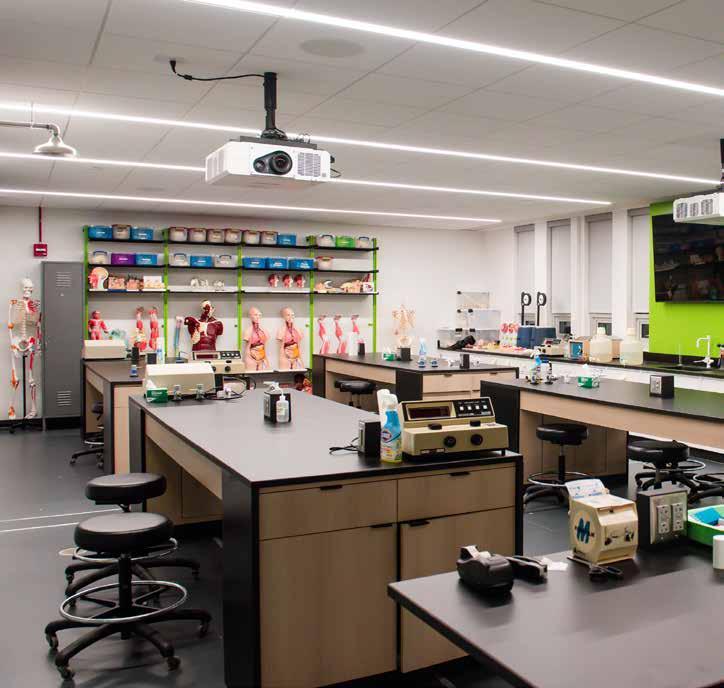
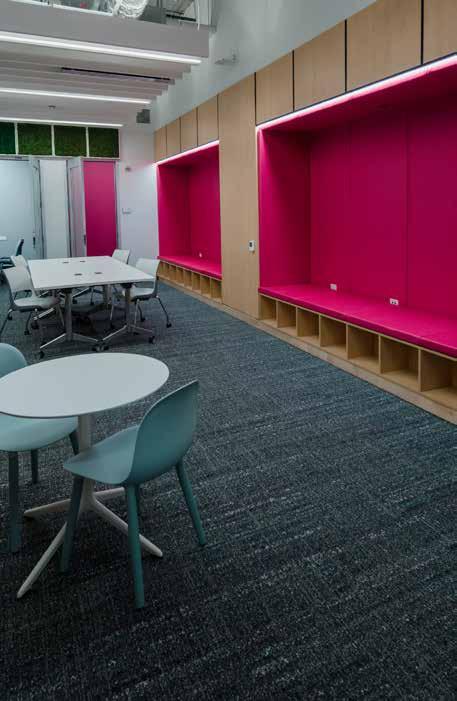
The law firm of Jackson Kelly PLLC leased new space in the Union Trust Building at 501 William Penn Place and took occupancy in early 2020. Construction started more than six months before word of a coronavirus entered our collective consciousness, but Jackson Kelly had observed trends impacting its business that were going to be magnified during the pandemic, trends that informed its decisions about location and design.
“We are about a 160-person firm. Recognizing that we were a firm that was not originated in Pittsburgh, we were looking for a way to differentiate ourselves from other stalwart firms to attract young talent. We thought the way our office looked would be one way to do that,” explains Michael Leahey, member and manager of the Pittsburgh office. “The way education has gone, both undergrad and law school, practicing law has become much more collaborative. Our lawyers work in groups, as opposed to sitting in their own offices working on cases. We thought a more open concept, with more shared public areas, was better suited to the practice of law moving forward. These decisions were all made pre-COVID, but now that we are all returning to the office model we’ve put together has worked well for us.”
Rick Avon, principal at Avon Design Group, the architectural firm
charged with designing the new space, says that the clarity of intent from Jackson Kelly benefitted the project from the start. “Jackson Kelly was a good client in that they knew what they wanted and how the space should function. They wanted a dynamic atmosphere that would attract young lawyers and impress their clients, and they also wanted more interactive spaces instead of more private offices. They were ahead of the game by seeing the trends in their own industry,” Avon says. “The space was not conducive to the old way of thinking about how lawyers worked. What allowed them to step into that space was the fact that they were willing to change the way they worked.”
The project involved tenant improvements to two floors. There were roughly 10,000 square feet fitted out on the 10th floor, with another 6,000 square feet on the connected 11th floor. One of the key elements of the space was its two-story atrium lobby, which had a staircase to the floor above and was topped with a massive structural skylight that had views of the iconic Gothic penthouses that top the Frederic Osterling-designed Union Trust Building. The renovation did not include any major structural or mechanical renovations, but involved construction of a new office layout, HVAC and electrical distribution, finishes, and furnishings throughout the space.

 JACKSON KELLY TENANT
project profile
JACKSON KELLY TENANT
project profile
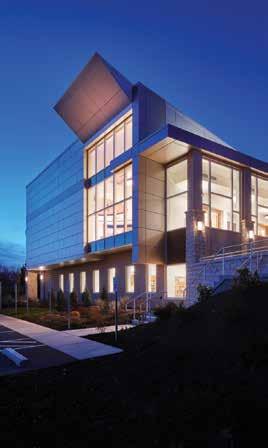
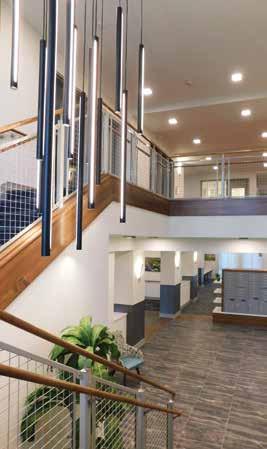



For the architects, the age and layout of the Union Trust Building’s upper floors offered both advantages and challenges in designing space that met the client’s needs.

“The stairs were there, as was the beautiful skylight that looks at the penthouse. Right off the bat they had a very dynamic space. The space is two stories that are connected and has a lot of natural light. Because everyone is not on the same floor there are more chances to have open offices,” Avon notes. “There are also some downsides to being spread over two connected floors. Noise can travel more easily. And no one wants to run up and down the stairs all day, so we needed to program what groups needed to be adjacent to others.”
“Jackson Kelly wanted the open office feel but still needed to have individual privacy because of the nature of their work. That is what drove the decision to use glass for the interior walls. You could take away the transmission of sound without taking away the views and the natural light,” says Meri Gregg, project manager and interior designer for Avon Design Group. “They also wanted the ceilings open to the deck for an industrial feel so it’s a challenge to have the duct work, piping, and electrical exposed and have it be attractive. The other challenge of having the ceilings open to deck is with acoustics. We were able to solve that with furniture, wall treatments, and carpet.”
Jackson Kelly engaged Chuck DiLoreto from NAI Pittsburgh to manage the design and construction process. DiLoreto hired Avon Design Group and selected TEDCO Construction as general contractor after a proposal and interview process.
“We knew enough to stay in our own lane and relied heavily on Chuck DiLoreto. They spoke very highly of Dave Leone and his team at TEDCO,” says Leahey.
Leone was TEDCO’s superintendent on the project. A veteran of tenant buildouts in the Golden Triangle, Leone says that the Union Trust Building is his favorite building in the city, although its vintage and unique architecture create challenges.
“The building had been around a long time and that was some of the challenge,” Leone says. “For example, there were archways on the 11th floor that were made of beautiful stone and four or five of them were offices that needed to be enclosed. We put glass in the archways so you could see into the atrium down to the 10th floor. It was quite a challenge to get the layout accurate so that the radius was tight. There was a lot of measuring and rechecking. There were fits and fails. In the end we had to modify it in the field to make it look like it grew there.”
There were places throughout the two floors that presented similar challenges of fit. Avon says Jackson Kelly was interested in having the space represent a connection to Pittsburgh and embraced the idea exposing the industrial elements of the building.
“Around the central atrium there was lots of stonework and large columns, which were boxed in and cumbersome. On a couple of them we rebuilt the enclosures around them and on many we exposed the columns,” Avon says.



The decision to expose the columns and stone meant that many of the partitions, millwork, and glass storefront for the office connected to an irregular surface.

“Anywhere where a partition met an existing column, we had a bit of modification to make to get it to fit,” says Leone.
Such fitting requires extra time to get right, time which was not abundantly available. Prior to the tenant buildout, during preparations to the base building by the landlord, The Davis Companies, unexpected asbestos had been discovered and remediated. As so often happens, that unforeseen delay prior to construction could not change the move-in date for Jackson Kelly, which meant that the schedule for the tenant improvements became more aggressive. Leone credits the landlord with accommodating TEDCO’s logistical needs to keep the job moving.
“At the time of this project the Union Trust Building was still going through a complete renovation. You can imagine what was going on in the building while we wanted our deliveries and shutdowns. But I don’t recall that they ever once didn’t accommodate us,” Leone says. The architect was awesome. Anytime I had questions or didn’t understand what they were looking for, they were always responsive. The same was true for Chuck DiLoreto from NAI and for Mike Leahey.”
“I had an interest in the project and enough knowledge about construction to be dangerous and was on site more than most law firm tenants would be. Dave and his group were always happy to talk through the issues they were having and kept me updated,” says Leahey.
“The project management team they had on site day-to-day was excellent. They were good liaisons between the construction team, building owners, construction manager, and us.”
Leone credits the subcontractors on the project, especially given the aggressive schedule and complications of renovating an old building.
“All the subcontractors followed our lead. We told them when the separate tasks had to be completed and they delivered,” he says. “When you have a smaller project with a limited schedule, it just takes one subcontractor to have a hiccup to cause a problem that cascades downhill for everyone. In that building, all our subcontractors were union, and I wouldn’t have done this job any other way. They were professionals. They understand that we’re all there to get the job done.”
Avon praised Leone’s problem-solving approach to the problems that arose.
“The one thing I respected about TEDCO was that they made our goals their goals. We both took on the task of doing the project for the client,” he says. “We worked together very well, and I wouldn’t hesitate to jump on a project with them. They were up front if something did come up. And it was brought up with an attitude of finding a solution.”
Leahey reports that the project wrapped up on time for the scheduled move-in date. He says that the finished product validates the choice of the space.
“From a construction standpoint TEDCO was dealing with a very old, architecturally interesting building that had been retrofitted several times,” he says. “They dealt with a lot of issues, both in terms of what the core of the building looked like and in building the mechanical, electrical, data, and modern amenities of an office. This space did not make any of that easy. TEDCO did a very nice job of working through those challenges.”
“The workmanship that TEDCO did was excellent,” Leahey continue. “When you’re dealing with a downtown office building you don’t think of craftsmanship in the same way that you do in a home, for example. Because of the interesting space we have there are a lot of historical elements, old stonework, and woodwork. Fitting modern finishes to old rough stone and wood is very challenging. TEDCO paid attention to those details. When you look through our offices you don’t see any of those glaring gaps between the old industrial elements and the modern drywall and glass. We’re very satisfied with the result.” BG
TEDCO Construction
General Contractor Jackson Kelly PLLC Owner
Avon Design Group Architect A & F Engineering Consulting Engineer
AMB Plumbing Inc. Plumbing Environmental Air Inc. HVAC
Fallon Electric Electrical Specified Systems Inc. Glass and Glazing Tech 2000 Casework and Millwork

Pittsburgh Interior Systems Painting
Dan Taylor Interiors Flooring
Bryan Construction Inc. Drywall/Interiors
Preferred Fire Protection Sprinklers
Zottola Fab Inc. Metal Railings Information Technology Services Telephone/Data
Since the 1999 enactment of the Pennsylvania Construction Code Act (“PCCA”), Pennsylvania has sought to establish uniformity for construction standards throughout the Commonwealth. In pursuit of uniformity the PCCA embraced the adoption of standards drafted by the International Code Council (“ICC”), a private non-profit entity, and directed the Department of Labor & Industry (“Department”) to promulgate certain ICC standards under the Uniform Construction Code (“UCC”). The directive to adopt standards originating from a non-governmental entity such as the ICC implicates a legal concept known as the non-delegation doctrine. The Commonwealth Court recently invoked the non-delegation doctrine to enjoin the enforcement of the 2021 accessibility regulations promulgated by the Department in Pennsylvania Builders Association v. Department of Labor & Industry, No. 479 M.D. 2021, 2022 WL 14668728 (Pa. Cmwlth. Oct. 26, 2022).
The non-delegation doctrine is embodied in Article II, Section 1 of the Pennsylvania Constitution where it states: “The legislative power of this Commonwealth shall be vested in a General Assembly, which shall consist of a Senate and a House of Representatives.” Together with Article III, Section 1 of the Pennsylvania Constitution addressing the passage of laws, the non-delegation doctrine constrains the General Assembly so that it cannot delegate its lawmaking power to any other branch of government, another body, or some other authority. Christ the King Manor v. Dep’t of Pub. Welfare, 911 A.2d 624 (Pa. Cmwlth. 2006), aff’d 951 A.2d 255 (Pa. 2008).
The Commonwealth Court’s recent decision in Pennsylvania Builders Association is the culmination of litigation filed by the Pennsylvania Builders Association (“PBA”) against the Department alleging that the ICC accessibility provisions adopted pursuant to Section 304(a)(3) of the PCCA (“Accessibility Regulations”) constituted an unconstitutional delegation of legislative authority.
On December 25, 2021, pursuant to Section 304(a)(3) of the PCCA, the Department amended Sections 403.21, 403.26, and 403.28 of the Department’s regulations and certain definitions in Section 401.1 to expressly adopt the ICC’s 2021 amendments to accessibility provisions of the International Building Code, International Existing Building Code, and International Swimming Pool and Spa Code. On December 29, 2021, PBA filed a complaint in the Commonwealth Court’s original jurisdiction alleging that the General Assembly delegated unfettered legislative authority to a private entity, the ICC, to establish accessibility standards, and that PBA and its members were aggrieved as a result. PBA claimed that the association and its members were denied the opportunity to provide meaningful comment during the promulgation process in addition to suffering future adverse economic impacts, delays, as well as foreseeable interpretive and enforcement difficulties. Section 304(a)(3) of the PCCA directs: “The Department shall promulgate regulations updating
accessibility standards under Chapter 3 [Uniform Commercial Construction Code] by adopting by December 31 of the year of issuance of the accessibility provisions of the most recently published edition of the ICC codes and any other accessibility requirements which shall be specified in the regulations or contained in or referenced by the [UCC] relating to persons with disabilities.” 35 P.S. § 7210.304(a)(3). PBA argued that Section 304(a)(3) is a directive that in its essence requires the Department to rubber-stamp into law whatever accessibility standards the ICC publishes, without a process to consider any alterations to those standards. Furthermore, that the General Assembly failed to provide any mechanism for the Department to question, modify, reject, or even independently review and concur with the accessibility standards the ICC creates.
This is not the first time that PBA has accused the Department of violating the non-delegation doctrine. The General Assembly’s previous solution to complying with the nondelegation doctrine while still upholding the purpose of the PCCA was to establish the UCC Review and Advisory Council (“RAC”). Established in 2008, RAC is charged with making recommendations to the Governor, the General Assembly, and the Department regarding proposed changes to the PCCA. Additionally, RAC is responsible for reviewing the most recent building code updates published by the ICC. RAC is authorized to make determinations as to whether any new or amended provisions of ICC’s codes are not consistent with the PCCA, or are inappropriate for inclusion in Pennsylvania’s UCC, and RAC is to notify the Department of the same by May 1 of the issuing year. When that happens, the Department must exclude the challenged provisions when adopting the UCC, thereby leaving the corresponding provisions of the prior UCC version in effect. In late 2010, PBA filed a petition for review seeking a declaration that the 2009 UCC and other related codes are null and void as violative of the non-delegation doctrine. However, the Commonwealth Court held that the 2009 UCC amendments were valid because the inclusion of RAC in the Department’s process to adopt the Pennsylvania UCC afforded oversight and input by industry members and meant that the Department could no longer adopt ICC’s codes “sight unseen.” Pennsylvania Builders Ass’n v. Dept. of Labor & Indus., 4 A.3d 215, 222 (Pa. Cmwlth. 2010).
As noted by the Commonwealth Court, the distinguishing factor in the current case challenging the Accessibility Regulations was that RAC was uninvolved in the process. Section 106(b) of the PCCA specifies that “the Accessibility Advisory Board shall review all proposed regulations under [the PCCA] and shall offer comment and advice to the [Department’s] secretary on all issues relating to accessibility by persons with physical disabilities, including those which relate to the enforcement of the accessibility requirements.” 35 P.S. § 7210.106(b) (emphasis added). On July 15, 2021, the Department sought input from the Accessibility Advisory Board which “expressed no concern with the proposed changes.” However, the
Department must only consider the Accessibility Advisory Board’s comments and advice in contrast with the binding determinations that are issued by RAC. The General Assembly has not expressly authorized the Department to alter ICC’s accessibility standards based on input from the Accessibility Advisory Board. Therefore, the Court found that due to the General Assembly’s statutory mandate that the Department must adopt the ICC’s accessibility codes without modification, the Accessibility Advisory Board’s review process does not in any way guide or restrain the ICC’s control over Pennsylvania’s UCC and the Department’s regulations.
Judge Covey, writing for the majority, stated: “The nondelegation doctrine prohibits the General Assembly from incorporating sight unseen, subsequent modifications to such standards without also providing adequate criteria to guide and restrain the exercise of the delegated authority.” Without the oversight of RAC in the promulgation process, the Accessibility Regulations were being adopted sight unseen and without any subsequent modification by the legislature. Therefore, the Commonwealth Court determined that Section 304(a)(3) of the PCCA contains valid provisions inseparable from invalid provisions, struck Section 304(a)(3) in its entirety from the PCCA, and permanently enjoined the Department from its enforcement.
After the Commonwealth Court’s ruling, it is likely that review of the ICC accessibility provisions will be referred to RAC and therefore avoid non-delegation doctrine issues in the future. Although it might seem like a short-lived win for PBA because the PCCA could utilize RAC to avoid the non-delegation
doctrine, there is a crucial argument to be made following the recent decision. Because Section 304(a)(3) of the PCCA was declared unconstitutional, there is a strong argument that the Commonwealth Court also rendered invalid all accessibility regulations previously promulgated pursuant to that provision; not just the 2021 Accessibility Regulations at issue in the case. Although some accessibility provisions have been promulgated under Section 301 of the PCCA, a great deal of the accessibility provisions were promulgated by adopting a successor or revised code under the authority granted by Section 304(a)(3). Furthermore, if Section 304(a)(3) is unconstitutional, as ruled by the Commonwealth Court, by necessary implication those previous accessibility provisions adopted as regulations should be invalid as well.
The Department did not file an appeal with the Supreme Court so the Commonwealth Court’s decision stands. We will continue to follow developments in this area of the law and its intersection with the design, construction, and inspection activities of the Master Builders’ Association of Western Pennsylvania’s members. BG

Act of November 10, 1999, P.L. 491, as amended, 35 P.S. §§ 7210.101-7210.1103; See Commonwealth v. Null, 186 A.3d 424, 427 (Pa. Super. 2018) (quoting Flanders v. Ford City Borough, 986 A.2d 964, 969 (Pa. Cmwlth. 2009)).
Max Junker is a shareholder at Babst Calland. He can be reached at rjunker@babstcalland.com. Anna Hosack is an attorney at Babst Calland. She can be reached at ahosack@ babstcalland.com.





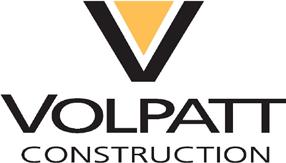

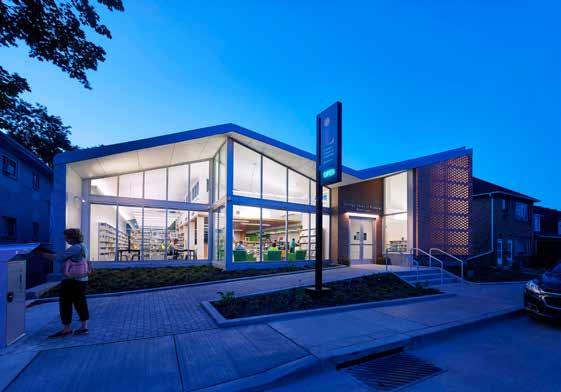
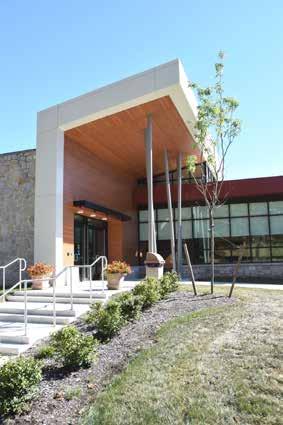


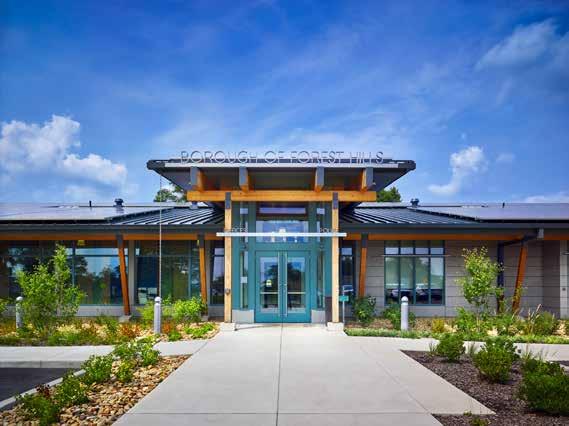
Every business has a revenue cycle, and constant cash needs. But unlike my favorite restaurant that gets paid immediately after serving my usual order, spicy tortellini, your construction company might not get paid for 30, 60, or even 90 days after service is complete and the job is done. Supply costs, labor costs, mobilization costs—there are many issues specific to construction that all add up to a unique cash flow process. Understanding how to improve your cash flow, and how it differs from your profit, is crucial to managing your company and avoiding the problems that come with poor cash flow.
A contractor might reason, “If a job is profitable, isn’t that all that matters? Why be concerned about my cash flow cycle?” Because a failure to actively manage your cash flow will seriously negatively impact your growth potential. Consider the findings of the Levelset 2022 Construction Cash Flow & Payment Report:
• While nearly two-thirds of businesses report profit margins greater than 10 percent, less than one-tenth of companies report being always paid on time for completed work.
• Companies most commonly offer payment terms of 30 days or less, but less than 40 percent of construction businesses report getting paid within 30 days on average.
• Explanations for slow payment vary, with half of subcontractors blaming the general contractor while 40 percent of general contractors blame the project owner’s financing.
Industry news source Construction Dive details the following most common cash flow issues:
• Cash is tied up in projects, used to pay for job-related bills and expenses.
• Customers are slow to pay invoices.
• The contractor submitted invoices that don’t cover the scope of the work.
• The contractor performed/paid for changes that have not yet been approved by the client; therefore, they remain unbilled.
• There are missed deadlines or other billing missteps due to a new client’s unfamiliar billing practices.
• There is an unexpected increase in operating liabilities like payroll taxes, union dues, insurance fees or other financial obligation.
While contractors tend to focus on the production side of their business, there are other considerations key to your financial success. Regardless of the size of your business, when cash flow isn’t prioritized, your business is vulnerable to unnecessary risks. Poor cash flow leaves you exposed to missing deadlines; vendors might not want to work with you due to payment issues; liens could be filed; and ultimately, your reputation is on the line. You can avoid such exposure by mastering your cash flow. Follow these tips to eliminate the struggle to move money around to meet your cash flow needs:
You have more control over your cash flow than you might think; it’s a matter of knowing your numbers. Open conversations with your suppliers and vendors can go a long way to managing and accessing your money. Review your billing process as regularly as your work completion process. Identify areas where there are breakdowns and work to improve them.
Additionally, consider steps like converting to digital invoicing and payment solutions. By taking advantage of technology, you can streamline the entire process and get paid faster. When cash flow is timelier, you can spend more time on growth and leads, less covering bills and payments.
Training is critical. Spending company resources to properly prepare your team to handle issues is a sure way to improve your operations. Every contractor does some training with their employees, focusing many times on performance and safety, but, are you training those on your team that help you control your company’s cash flow process?
It is critical that project managers and office staff understand your billing process. Training helps them understand their role in the process and the changes they can implement to help make your company more profitable. Do your project managers understand how the timing of cash receipts can reduce your interest expense? Does everyone understand that vendor discounts can provide for substantial savings for a contractor with strong cash flow? Too often, construction team members do not fully grasp all they can do to help make their company more profitable by improving cash flow.
While some shy away from pursuing late payments, it is simply good business to request payments you are owed. There is a distinct difference between being straightforward and being aggressive. Do you have a team member who is in charge of paying attention to your collections? Do you know
how many days it typically takes your business to get paid? Sending friendly reminders to your clients who aren’t paying on time is an important part of a good business plan.
You might also consider being more flexible in how you accept payments. The more convenient payment options are for clients, the faster they can pay. If nothing seems to be working, sending a preliminary notice can sometimes be equally as effective as a mechanic’s lien at getting the property owner or contractor to make a payment.
Let me guess: You have communication issues between the field and the office. That is the case with every contractor we talk with. But a consistent, focused effort can improve communications
The best contractors have a proven system in place to accelerate the cash flow cycle related to their invoices, including billing for the extras as they are completed, or even ordered. If you find yourself collecting change orders well after the job has wrapped up, you need to improve your process to improve your cash flow cycle and avoid being the one financing the work.
The most successful contractors know the “art of the bid.” On bids with multiple line items, consider increasing the value on items that will be performed early in the contract. Items like mobilization, when it is not limited, are where savvy bidders will increase their values to accelerate their cash flow early in the contract cycle. Focusing significant portions of your bid online items that are likely to be paid first can make a dramatic difference in your cash flow. This strategy allows the contractor to use the owner’s money to help finance the job.
Some contractors feel like their hands are tied with contracts, but you need to question unfavorable contract terms and stay transparent about your business needs. This is all about protecting your business. Don’t leave anything unaddressed that you’re not comfortable with. If your clients don’t have to pay you until they “get around to it,” you’re creating a perfect opportunity for extensive delays or even missed payments.
in a reasonably short time period. These issues often come down to understanding the challenges that each side is facing and being empathetic about the causes of the problem, even inadvertent ones. Once your entire team is working together toward the goal of improving cash flow, everyone on the team will see where they can contribute to improvements.
Easier said than done? Most contractors use change orders throughout their projects, which are, almost always, not finalized until the last parts of the job. Change orders are “interest free loans” to the project owners. A typical scenario involves a contractor performing these “extras” throughout the job, then waiting until the end to invoice them. Invoicing is followed by 30 to 60 days of negotiation over the amount of the invoice. Once the amount is agreed to, the contract owner takes another 60 days to pay the invoice. The result: a huge strain on the contractor’s cash flow.
The contract should specify the scope of the work, payment schedule, and legal repercussions of late payments. Remember that your lien rights are designed to protect you. For more than two centuries, the mechanic’s lien has been empowering materials suppliers, contractors, subcontractors, and other construction stakeholders with the most effective weapon they can wield against delinquent or non-paying clients. You want to get liens filed on anything that’s unpaid or late, but a more proactive move is to issue notices that ensure your lien rights are always protected as you get more work.
When you walk onto a construction site, there is an entire community of stakeholders on the job. You are under enough pressure without cash flow issues. Being more assertive in your cash flow approach can help save critical dollars on interest, grant you more purchasing power with suppliers and allow you to be available to take advantage of growth opportunities when they arise. No matter how talented you are, or how dedicated to your craft, if you haven’t dedicated the time to improve your cash flow, you’re not setting yourself up for success. BG
Mike Kapics is principal and national director at HBK Construction Solutions. He can be reached at mkapics@ hbkcpa.com
Do your project managers understand how the timing of cash receipts can reduce your interest expense?
Does everyone understand that vendor discounts can provide for substantial savings for a contractor with strong cash flow?
For over 100 years Local 66, in partnership with our employers, has been committed to providing qualified and competent Operating Engineers. For Local 66, meeting your short and long term employment needs is a priority.

The Operating Engineers lead the nation in pipeline training.


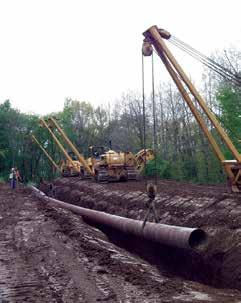
The best trained, most capable work force. Professional tradesman and tradeswomen have received the specialty training needed to meet the complex challenges of your project.

Services you can count on. We’ll work with you to answer any questions or solve any problems at your convenience.

Smart business know-how. You’ll benefit from our years of experience and a proven track record we bring to the job.
Bottom-line dollar-for-dollar value. Value is bringing the highest professional and performance standards to your job site – from the beginning of a project to its completion. We at Local 66 are committed to being the premier value provider of Operating Engineers in the region.

Here’s how operationally superior organizations manage work in the field and the steps that companies can take to join the ranks of the industry’s best-in- class firms.
For many engineering and construction (E&C) firms, the first area they turn to for improvement is the field, since it often seems to be the easiest place to work on efficiencies. Yet, operationally superior organizations know that you must implement the right practices, processes, and people across the organization – including field teams.
Many companies don’t truly understand what it means to be an operationally superior field organization. For example, many measure success on the result. They’ll judge a superintendent or field leader on whether a project is finished ahead of schedule, safely and/or ahead of budget. What they don’t always realize is that just because no one was injured on the job site doesn’t mean that the interim processes went smoothly. By evaluating only the result, E&C firms miss out on an opportunity to achieve overall operational excellence.
Busy, fast-paced construction sites may include hundreds of workers and a team of field leaders who manage logistics, safety, costs and other functions. Planning, including budgets, resources and scheduling, is critical.

The best field leaders are those who serve not only as the nexus within all these arenas but also, more importantly, as the driver of true collaboration across a project. Whether a firm is a trade contractor that self-performs work, a general contractor that brokers all of the trades, or even a combination of the two, a successful field leader is proactively pushing collaboration and thinking ahead.
Every project has a strong, realistic budget that begins with the project manager and field leader reworking the estimate for the project and assigning budget codes with the way it will be built in the field.
This is important because you can’t have consistency and
operational excellence without buy-in from the field. If a supervisor gets a budget and instantly knows that the task can’t be completed for that amount of money, he must be able to discuss it in advance (versus addressing it after the fact). To be clear, the contract amount is established. The purpose of this phase is to create a budget that the field leader believes in. If the project goes over budget, it was likely always going to. However, if the field leaders are encouraged to recognize and identify issues early, they can help produce better overall job outcomes. So rather than having the budget quickly approved in the preconstruction phase, companies that take the time to carefully review them can get an idea of overruns or underruns and come up with a plan for addressing them early.


A stop-gap measure, early detection of budget problems correlates directly with improved collaboration and strategic planning on projects of all sizes. This, in turn, continues that evolution of collaboration from preconstruction right out to the field manager level. Everyone wins when this happens.
Another important part of collaboration is planning. Operationally superior field leaders plan a minimum of a week ahead, using some sort of planning tool. These tools manage resources like labor, materials, and equipment, plus

the activities of any trade partners.
Industry tools such as short-interval planning, lean last planners and pull planning are examples of best in class. The operative word in all of this is planning.
There are also countless scheduling tools; but this is not about creating a critical path schedule but thinking ahead and developing a proactive strategy.
When field leaders have a tool they can use consistently, they can lay the foundation for steady and predictable work. The tool should also be made accessible to leaders of subcontracting firms (e.g., excavators and plumbers) who can use it to communicate with the general contractor and, if applicable, with each other. This tool should be used regularly across the organization and by all stakeholders.
When projects are planned, everyone is working from the same playbook, field leaders know they have two-way communications with the head office, and construction projects run more smoothly. For operationally superior organizations, reactive, emergency calls to a central warehouse, shop, yard, etc., are truly nonexistent except for unforeseen conditions. This is an important point for field leaders and supervisors who treat their companies’ warehouses and yards like convenience stores, when they should only be tapped during emergencies. Rather than stopping by a warehouse to pick up materials, supervisors should plan and only use

the shop when unforeseen issue arises (e.g., someone hits a water line while digging and needs a sump pump quickly).
After weekly schedules are made, operationally superior companies also plan daily with a focus on production targets and real-time job hazard analyses. Much like the earlier budgeting advice, these activities should be conducted collaboratively across the office, field leaders and crew.
Financial AcumenField managers at operationally superior E&C companies are intimately familiar with the budget for all costs, including, but not limited to, vendors, trade contractors,

self-performance areas and general conditions. They always know what’s going on and can intervene at any point where they see a potential problem.
They have a deep understanding of the general conditions, burn rate, utilization and other metrics that go into the financial side of project management. Historically, there has been a mindset that the financial perspective of the project was the sole province of the project manager. However, best-of- class organizations realize that you cannot expect strong financial performance when your primary project driver is removed, disconnected or disinterested in the financials.
Field supervisors understand the difference between cost and margin. If the total price of the project is reduced to meet a customer’s budget, costs are not arbitrarily slashed. Methods and means are examined for cost efficiencies, but margin is also adjusted to portray reality. If the margin is set at 10%, for example, field leaders are ultimately going to influence whatever gain the contractor makes on the project. Margins can be improved by getting the best productivity and yields out of their existing materials, improving general project conditions, or utilizing equipment better.
At leading E&C companies, field leaders also understand the difference between quality assurance and quality control and make that one of their key priorities. Quality assurance is the standard for how work is put in place. It is the playbook that the organization follows every time to create a quality product. Quality control is the testing component that assures the guidelines and end results meet those standards and jobs are being continually monitored. However, if a field leader focuses solely on quality control, he or she is largely playing defense and reacting to conditions as they arise.
Superior field leaders focus on driving quality every day. They have adopted the phrase “punch as you go,” which becomes the mantra for not leaving miniscule items to build until the end of the project. Quality assurance requires a strong company philosophy, combined with a strong individual mindset.
Planning and scheduling are both important for leading organizations. All projects should have a baseline schedule, and that schedule should be updated by the project teams on a regular frequency. Using basic software tools like Microsoft Project, for example, companies
can get their labor-intensive contractors and subcontractors on a common platform and adhering to the schedule.
Any project’s issues and challenges (i.e., weather, delays, shipments, etc.) should also be presented on the schedule to reflect the reality of the job site conditions. For example, if it’s raining or if the jobsite is temporarily flooded, then the schedule should reflect the reality of the project in real time so that everyone can adjust accordingly.
This also helps when presenting proof to project owners, who may not always understand why a delay happened. Too often, projects that are met with massive issues, such as claims, design issues, delays, etc., do not reflect those on the schedule, only to be met with legal hurdles. Field leaders understand how to portray realism to protect the firm.
Construction is obviously a dirty activity; yet, operationally superior organizations understand the difference between cluttered, trashed and dangerous versus typical day-to-day operations. In operationally superior companies, job sites are clean, maintained and well organized – each trade is held accountable for its own waste cleanup, and adherence is monitored daily.
The job site that’s strewn with debris and litter is not only unsightly but also dangerous and a huge liability and safety concern. Not to mention, you eventually must clean everything anyway, so why not clean daily to avoid a massive effort at the end of the project? Once again, punching as you go means more than just repairing drywall and damaged concrete. Cleanliness is the hallmark of safety, productivity and field leaders who know how to get work done.
Change is inevitable. No job adheres directly to plans, thus change orders, which can be a challenge to manage and communicate across an organization.
Change orders have a defined structure and adhere to a
checklist that guarantees items, such as where a change is located. There is also back-up support for the change, and breakdowns of costs are all included to avoid needless delays in processing.
It’s also important for change orders to be processed quickly and approved to avoid project delays. In the best companies, change orders do not linger – escalation of older change orders ensures action is taken sooner rather than later. These changes orders should have a series of gates, or specific deadlines and procedures, that ensure timely approval and payment.
Best-in-class field leaders manage change proactively and ensure that all aspects of those changes – schedules, deliveries, coordination, etc. – are integrated and communicated to all stakeholders. The project or operations manager should review, approve or reject these change orders and ensure that the project owner also agrees.
A final area that most of the leading E&C companies stand out on is with their focus on productivity. They’re hyperaware of the connection between efficiency and labor productivity, and they take steps to maximize both in the safest and most logical manner possible. They also know that there’s a difference between productivity (the productive effort’s efficiency, as measured in terms of the rate of output per unit of input) and production (the total output), and they understand which one most favorably impacts their profitability. In most situations, it’s productivity— and not the production itself—that delivers the best project outcomes. So, while customers care the most about output and don’t really care how much labor it takes to get the job done, top-performing, labor-intensive companies are hyper focused on productivity; that’s where the money is made. BG
Gregg Schoppman is a partner at FMI, specializing in productivity and project management for general and trade contractors across the country. Gregg can be reached at gregg.schoppman@fmicorp.com.
Any project’s issues and challenges (i.e., weather, delays, shipments, etc.) should also be presented on the schedule to reflect the reality of the job site conditions. For example, if it’s raining or if the jobsite is temporarily flooded, then the schedule should reflect the reality of the project in real time so that everyone can adjust accordingly.

What people want and need from built environments is evolving. The ways people come together and inhabit physical space have been irrevocably changed by the pandemic; environmental justice; and diversity, equity, and inclusion integration. As building professionals and consultants, we seek to understand the long-term ramifications of these societal-level forces.
Recent studies by CBRE show 87 percent of large companies are shifting toward a hybrid work environment (CBRE, U.S. Real Estate Market Outlook 2022). According to a recent survey conducted by PricewaterhouseCoopers LLP, 22 percent of companies are scaling back their real estate investments (Pittsburgh Business Times, “PwC real estate head: How companies evaluate office-space needs if there’s a recession”).
Our region is no exception. Recent headlines continue to show large companies reducing their footprint and moving toward more collaborative and usable space. The iconic Strip District has become a destination for hybrid work environments for several companies. Other companies are reducing their footprint and opting for space in a building offering new and upgraded amenities.
While downsizing may be tempting from a short-term budget perspective, consider whether a shift would support your culture and your organization’s ability to meet its strategic goals. Traditional office uses may be less relevant now; however, a reimagined office can offer benefits unavailable at home offices. You now have the opportunity to reconsider and redefine what “the office” means to your organization. By understanding your needs, you can leverage site selection, size, and layout to support your company’s goals.
Over the past three years, employees have become accustomed to working from home. For some, when considering efficiency as the primary work driver, being remote represents a more practical way of working. However, the office provides more than just heads-down space. Humans are inherently social beings, and in our work, we desire connection, both purposeful and social. Keep connection and interaction in mind while locating, sizing, and designing space.
One desk per person is no longer a predictable formula for office footprint and may oversize your actual needs. Of course, there is no one-size-fits-all solution. Accommodating
the needs of employees with diverse work activities and different work preferences in one environment is a challenge. Finding a new space or reshaping your existing facilities to meet your organization’s practical and cultural needs is a complex task. Moreover, the increasing demands for virtual meetings, hybrid engagements, and smaller break out spaces have placed more emphasis on a reliable technology infrastructure to support and connect employees, both in and out of the office. Additionally, building amenities and services that residential neighborhoods may not provide, such as convenience shopping, daycare, convenient public transportation, and access to nature or park settings, are becoming increasingly important as draws back to the workplace.

For many organizations, rent, facility operations, and maintenance make real estate one of the largest expenditures of valuable capital. In a time of such change, how can you better manage your office portfolio? Rightsizing, better using existing space, or adding amenities provide opportunities to improve employee experience and strengthen your culture.
Previously, it made sense to apply a square foot per employee solution–in a space where everyone has a dedicated seat, such a ratio is a valid way to calculate your floorplate. In the hybrid world, this is frequently no longer the case. However, efficient use of space does not necessarily mean reducing space; instead, companies should focus on rightsizing. Designing for the engagement and culture you want to encourage requires exploring what your workplace needs to look like to support your organization.
As an example of culture driving workplace solutions, in a recent office renovation, we strategically reduced the size of individual offices to make space for more workstations and collaboration spaces. Further, based on employee behavior, we removed meeting tables in most private offices. We designed open workspaces with huddle and reservable conference rooms, hoteling desks, and a larger conference room to accommodate most of the office population. We added amenities to support office functions, such as efficient copy/print areas and a pantry dedicated to the space, as this client often hosts guests and finds that food is an important part of their culture in bringing employees together. The renovation more than doubled the common/collaborative areas, from 14 percent to 32 percent. Further, our efficient space allocation allowed for even more dedicated workspaces. Previously, the building accommodated 77 employees with an allocation of 239 square feet each. This thoughtful space reallocation allows for 86 employees at 170 square feet each.
When considering the amount of space needed, think about different staff populations over the longer term and consider what employees want and need while in the office. Before deciding on a strategy, it is critical you understand both where you are and where you want to go as culture drives the appropriate response. A professional can guide you through the problem identification and programming process. To begin, spend time observing how people work in the office. What do they spend their time doing? What challenges are they facing? Where are the efficiency gaps that can be addressed with thoughtful, targeted design?
Another valuable tool to capture critical data to inform physical environment requirements is a survey. Engage with employees about how the office is structured and based upon the survey themes, hold active listening sessions. By doing this work, you can build a shared understanding around the purpose of your office renovation and drive effective work environment transformation.

Additionally, building owners with tenants should look at common area amenities such as large conference rooms and hoteling spaces to retain tenants who will downsize or renovate to make better use of their space, as well as improve the overall building usage and return on investment.


Recently, our AE Works team completed two different office renovations in the same building. Each project had the same building layout and was supported by the same base building systems. However, the design results were completely different–a function of two very different work cultures.
For the first renovation, culture drove the planning and design process from the start. A very inclusive engagement process involved all employees in the office. Several rounds of surveys, focus groups on work behaviors, and open design reviews provided insights when developing the floor plan. The feedback centered on a desire for increased collaboration and informal workspaces.
The final floor plan completely transformed inefficient and dark office suites into an open, light-filled workplace. Private offices and large meeting spaces are all oriented around a central, flexible core with space for collaboration and the opportunity for chance meetings to bring a greater sense of community.
Design driven by culture: balancing private workspace for headsdown work with open, flexible communal space–opening up options for all employees. Photo by Ulf Wallin Photography.



The second renovation was driven by a different engagement process and culture. Visiting donors and guests are important to this organization’s mission. To accommodate these unique cultural elements, we decreased dedicated office space to create areas for entertaining and educational programming. Leadership provided insights around group work behaviors and, later in the process, a stakeholder group was formed to provide input on furniture design, office and work surfaces, and material preferences.
The two plans, while extremely different, reflect sensitivity to culture, process, and maximizing space to support the mission and goals of both organizations.

Offices serve different purposes for different organizations. A footprint-determined solution in a hybrid world may no longer fit your culture and goals. Exploration around the purpose of your space, particularly focusing on what employees can access at the office that they cannot as effectively do from home, is a critical starting point, and can reinvigorate the purpose and place your office space services for your organization to deliver new value. BG

Sources: CBRE, U.S. Real Estate Market Outlook 2022: https://www.cbre. com/insights/books/us-real-estate-market-outlook-2022/ office-occupier
Pittsburgh Business Times, “PwC real estate head: How companies evaluate office-space needs if there’s a recession”: https://www.bizjournals.com/pittsburgh/news/2022/09/07/ pwc-real-estate-office-space-recession.html
Tiffany Haile is an associate principal, planning and project services at AE Works. She can be reached at tiffany@ aeworks.com. Mark Logston is chief development officer at AE Works. He can be reached at mark@aeworks.com.







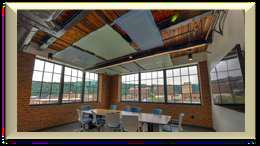
MICA members are interior contractors who share a common mission: to provide their customers with the highest quality craftsmanship. We partner with the union trades that supply the best trained, safest and most productive craftsmen in the industry.

Alliance Drywall Interiors, Inc.
Easley & Rivers, Inc.
Giffin Interior & Fixture, Inc.
J. J. Morris & Sons, Inc.
Bank of America South Hills Village
T. D. Patrinos Painting & Contracting Company
Precision Builders Inc.
RAM Acoustical Corporation
Wyatt Inc.
Interior contractor: RAM Acoustical Corporation
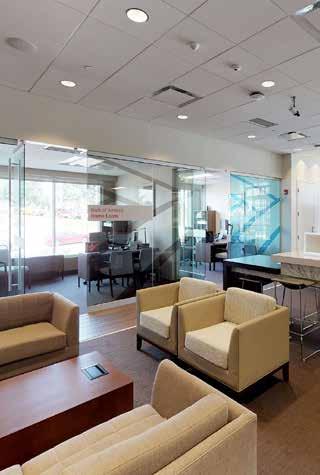
Another high quality MICA project

With Michael Mascaro (front) are Mascaro’s Deb Saus, Kristina Falvo, Jess Ramsey, and Howard Solomon from the Mason Contractors Association of Western PA at the MBA’s Bike Quiza-Thon, which benefitted Children’s Home of Pittsburgh.





(Front from left) Jamison Vernallis from Landau Building Co. and Naley McKamish. (Rear from left) David Morrison from PJ Dick, Landau’s Derek Thompson and Chet Beres, and Dom Mattarazzo from PJ Dick.
(From left)
(Front
(Rear
Jacob Clegg, Cameron Watters and Brittany Coscia from Dick Building Co., and Zane McShane from Nicholson Construction. Alex Dick is in front on the bicycle. from left) Mascaro’s Ed Hasis and John A. Mascaro, and Alexandra Masters from Turner. (Rear, from left) Zack Brandy and Corey Krieger from Mascaro, and Turner’s Abby Krehl.



 (From left) Rycon Construction’s Kim Cleckley, Kenya Finn, Ryan Ernst, and Amanda Caso the MBA Young Constructors holiday party.
Drew Kerr from Turner Construction (left) with Chad Brinkley from CT Projects at the NAIOP Pittsburgh Night at the Fights on November 11. Photo by JMilteer Photography.
(From left) Rycon Construction’s Kim Cleckley, Kenya Finn, Ryan Ernst, and Amanda Caso the MBA Young Constructors holiday party.
Drew Kerr from Turner Construction (left) with Chad Brinkley from CT Projects at the NAIOP Pittsburgh Night at the Fights on November 11. Photo by JMilteer Photography.




 (From left) Casey Schlaegle from Schaegle Design, MBA Executive Director Dave Daquelente, and Rycon Millwork’s Danielle McCullough. Photo by JMilteer Photography.
(From left) Rocky Bleier Construction Group’s (RBGC) Brian Baumeister, Laura VanVorce, and Kristy Kayafas, Katie McAuley from Rebuilding Together Pittsburgh, and JohnTobin from RBGC.
(From left) Casey Schlaegle from Schaegle Design, MBA Executive Director Dave Daquelente, and Rycon Millwork’s Danielle McCullough. Photo by JMilteer Photography.
(From left) Rocky Bleier Construction Group’s (RBGC) Brian Baumeister, Laura VanVorce, and Kristy Kayafas, Katie McAuley from Rebuilding Together Pittsburgh, and JohnTobin from RBGC.



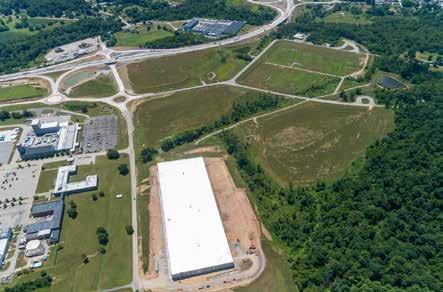




 (From left) MBA Executive Director Dave Daquelente, Joe Chaffin from Michael Baker International, and Burchick’s Dave Meuschke at the AIA-MBA Joint Committee’s Owner’s Roundtable.
(From left) MBA Executive Director Dave Daquelente, Joe Chaffin from Michael Baker International, and Burchick’s Dave Meuschke at the AIA-MBA Joint Committee’s Owner’s Roundtable.
Mascaro’s Guest Bartender Event was able to return this year after a two-year hiatus. Thanks to the generous donations of our guests, we were able to raise over $31,000 for the Cystic Fibrosis Foundation. Pictured from left are Mascaro’s Nate Martin, his daughter Sofia, and John C. Mascaro Jr.

Mascaro held Pink Day in October in honor of Breast Cancer Awareness and raised over $3,400.




Jendoco Construction’s CEO Domenic Dozzi was honored by the Crohn’s and Colitis Foundation for his service and support of the efforts to treat and cure Crohn’s Disease and colitis. Picture from left at the foundation’s Night of Steel gala are David Johnson from WPXI, Eric Hecker from the Crohn’s and Colitis Foundation, and Dom Dozzi.





















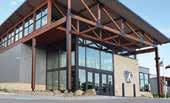




Allegheny Construction Group was awarded a $3.15 million contract for the general trades portion of the Commonwealth Charter Academy build-out at Cranberry Business Park. Shannon Construction is the construction manager. Strada Architecture LLC is the architect.
Allegheny Construction Group is the general contractor for the million-dollar renovation of the Center for Media Innovation at Point Park University. The architect is LGA Partners.
Fred L. Burns Inc. is the general trades contractor for the $7.3 million Clearfield Readiness Center Renovations and Improvements for the Department of General Services in Lawrence Township, Clearfield County. The architect is Upstreet Architects.
PA Department of Transportation awarded a $13.2 million contract to Mosites Construction for the renovations to the Armstrong Tunnels, located between Forbes Avenue and the 10th Street Bridge. Gannett Fleming is the engineer.
Mosites Construction was awarded the general construction contract for the Pittsburgh Regional Transit South Hills Village Maintenance Center Paint Booths. The $6 million project was designed by Whitman Requardt & Associates.
Action Housing Inc. awarded Mosites Construction contracts for two proposed projects. The $15 million Bethlehem Haven Uptown Flats in the Uptown neighborhood of the Hill District will be designed by LGA Partners. RSH Architects is the architect for the $22 million adaptive re-use of the Allegheny YMCA on the North Side.
AIMS Construction is renovating laboratories in Mellon Hall for Duquesne University. The architect is MCF Architects.
UPMC selected AIMS Construction to perform first impression renovations to the UPMC Shadyside Hospital. The architect for the $2.3 million lobby and corridor upgrade is RM Creative.
AIMS Construction is the construction manager for $2.3 million renovations to University of Pittsburgh’s Forbes Hall. The Design Group is the architect.
Uhl Construction was awarded a $5 million contract for a new maintenance and storage facility for Cecil Township, Washington County. The engineer for the 30,000 square foot pre-engineered building is Gateway Engineers.
Calgon Carbon awarded a $1.2 million contract to Uhl Construction for renovations to a portion of its administrative space. Providence Engineering designed the renovation of 6,000 square feet of 1940s-era office and lab space, which includes conference rooms, restrooms, break, and utility
rooms. The work includes a new roof, mechanical and electrical systems, and new fire protection.
Shannon Construction is the construction manager for the new Commonwealth Charter Academy in Benner Township, outside State College, PA. The architect for the $5 million renovation of a former industrial building is Strada Architecture LLC.
ElevateBio LLC and University of Pittsburgh selected Turner Construction as construction manager for the new $65 million Pitt BioForge BioManufacturing facility at Hazelwood Green. The architect for the 170,000 square foot facility is HOK.
FMS Construction is the general contractor for the 20,000 square foot expansion and renovation of the Kuhn’s grocery store in Bellevue. The architect for the project is Wildman Chalmers Design LLC.
DiMarco Construction is the general contractor for a new 2,500 square foot automated car wash facility at 4808 Baum Boulevard. The architect is Indovina Associates Architects.
Moon Township Supervisors awarded a $4,155,925 contract to DiMarco Construction for the general construction portion of its new $6.8 million Police Station. Lennon Smith Souleret Engineering is the engineer for the 17,300 square foot new facility.
Jendoco Construction is the general contractor for the $5 million addition and renovations to the Church of the Ascension in the Shadyside neighborhood of Pittsburgh. The architect is Rothschild Doyno Collaborative.
Caliber Contracting Services was the successful general construction contractor on the $2.4 million secure entrance renovations at Frazier High School in Perryopolis. The architect is DRAW Collective.
Caliber Contracting Services was the low general construction bidder for the rehabilitation of the Organized Group Camps at Laurel Hill State Park in Somerset County. Murphy & Dittenhafer Architects is the architect for the $2.3 million renovation for the PA Department of Conservation and Natural Resources.
City of Pittsburgh awarded a $2.8 million contract to Massaro Corporation for the general construction portion of the renovations to 412 Boulevard of Allies for the offices of Permits, Licenses, and Inspections. The architect is AE7 Architects.
Massaro Corporation was selected by Covestro as general contractor for the $10 million renovations to its offices in Robinson Township. IKM Inc. is the architect.
Massaro Construction Management Services is the construction manager for the $6 million Beaver Area High School/Middle School Phase 5 renovations in Brighton Township. McLean Architects is the architect.
Bethel Park School District selected Massaro Construction Management Services as construction manager for its new $95 million elementary school. DRAW Collective is the architect.
Pennsylvania Department of Transportation awarded a $55.9 million contract to Independence Excavating Inc. for reconstruction of Route 228 in Butler County.
A. M. Higley Company was selected as construction manager for the addition and renovation of the Pittsburgh Glass Center on Penn Avenue. Indovina Associates Architects is the architect for the $8 million project.
A. M. Higley Company is the general contractor for Aurora Flight Services facilities in Bridgeport, WV. The architect for the $15 million project is WYK Associates.
Mascaro was awarded the building and equipment foundations along with the contract to erect a 111,000 square foot melt shop building for Perryman in California, Pennsylvania.
Mascaro was selected to erect the structural steel and metal deck for the new Comcast building under a contract with Maccabee Industrial.
Mascaro’s Client Services Group is working on The Hazelwood Initiative project. The Initiative includes improvements and repairs to eight residential dwellings in the Hazelwood community of Pittsburgh. Repairs vary from new windows, exterior doors, kitchen cabinets, replacing leaky faucets, patching existing walls and ceilings, basement wall waterproofing patching, and new GFCI receptacles in bathrooms.
The Woodlands Foundation selected A. Martini & Co. as general contractor for renovations to its amphitheater in Marshall Township. DRAW Collective is the architect.
PJ Dick is providing CM at risk services for the new classroom and lab building for the University of Pittsburgh at the corner of Fifth and Halket. The facility is scheduled to complete in 2024.
PJ Dick is providing CM at risk services for the renovation of approximately 1,670 square feet of space in Bakery Square’s former Ragged Row space into a new Japanese pub-style restaurant.
PJ Dick is managing the tenant fit-out for Balvanera, a New York-based Argentine restaurant. The restaurant will occupy 4,400 square feet of the ground level of 1600 Smallman.
PJ Dick is managing the replacement of metal cladding on the Heinz Chapel facade spire, steel repairs and finishing on structural spire, and limited replacement of slate roof tile. The spire is approximately 120 feet tall.
PJ Dick began renovations to the fifth through eighth floors of the University of Pittsburgh’s University Club to convert existing Family House hotels rooms to student housing. The project includes HVAC and electrical upgrades as well as new finishes.
PJ Dick Mid-Atlantic is providing general construction services for St. Rita’s Hall at Villanova University. St. Rita’s Hall is an existing four-story, 17,000 square foot stone masonry building that was built in 1912 and includes an attached chapel. The building will be completely renovated and modernized including new star and elevator additions to meet code. Upon completion in late 2023, the building will be used as the university’s interfaith hub, housing the offices of Campus Mission and Ministry.
Rycon’s Special Projects Group is handling the new 40,000 square foot UFC Gym in Pittsburgh’s Market Square.
In downtown Pittsburgh, the restrooms on floors one through five of the Firstside financial office are undergoing a $2.1 million renovation by Rycon’s Special Projects Group.
Rycon’s Special Projects Group is the construction manager for the 3,300 square foot relocation of Hens and Chicks, a floral boutique in Pittsburgh’s Strip District.
A 28,700 square foot vacant warehouse will be transformed into a $1.5 million Bobcat dealership in Perryopolis by Rycon’s Special Projects Group.
Totaling over $1 million, Rycon’s Special Projects Group renovating three Starbucks locations in PA: Racetrack Road in Washington, Meadville, and Pleasant Hills.
Volpatt Construction is the general contractor for the UPMC Shadyside Hospital Linear Accelerator project. The architect is CPL Architecture Engineering Planning.
Buccini Pollin Group selected Carl Walker Construction as general contractor for the 910-car parking garage at the LiveNation! entertainment complex, part of the next phase of its redevelopment of the former Mellon Arena site in the Lower Hill District. The architect is Desmone Architects.
City of Pittsburgh awarded Allegheny Construction Group the general contract for the renovations to the historic Oliver Bath House on 10th Street in South Side. Buchart Horn Associates is the architect.
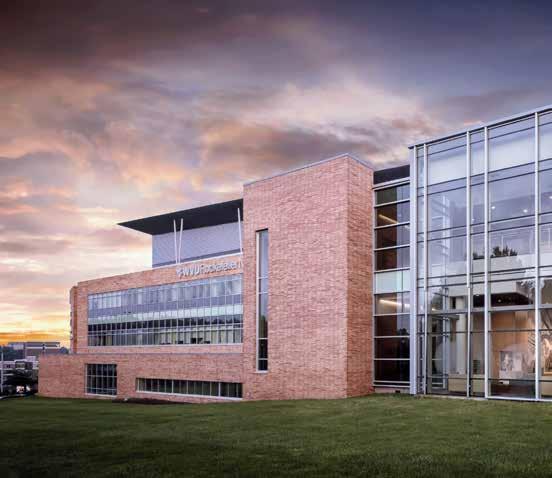
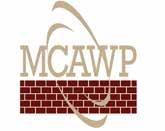

Ron Gessinger was promoted to project manager at Rocky Bleier Construction Group (RBCG). Gessinger was previously superintendent and general superintendent at RBCG. Gessinger attended the University of Pittsburgh and began his career as a carpenter in 1989.
Jendoco Construction Corporation welcomed Amber Chambers as project manager. Amber has more than seven years of project management experience across many industries.
Jendoco Construction Corporation welcomed Marta Dozzi as accounts payable/payroll administrator. Marta has over seven years’ experience and is a graduate of the University of Pittsburgh.
Penn State University announced that a classroom in its new College of Engineering building will be named after George Mezey and Jeff Turconi from PJ Dick/Trumbull. Penn State graduates, Mezey is a retired president of Trumbull Corp. and Turconi is the president of PJ Dick Inc.


Josh VanFosson joined Mascaro on November 21 as a desktop and mobile device administrator in the IT department.
Nick Leonzio joined PJ Dick’s Self-Perform Group as assistant project manager. Leonzio graduated from Robert Morris University in 2015 with a BS in mechanical engineering.
Brandon Del rejoined PJ Dick as a cost accountant. He previously worked for FedEx Ground, One Thirty One East, and Fischer and Co. Brandon is a graduate of Robert Morris University with a BSBA in accounting.
Anthony Altaher joined PJ Dick as an assistant project manager at the Pittsburgh International Airport Terminal Modernization project.
Independence Excavating Inc. announced that Steven Yeckel has been hired as civil safety director.
The Rycon Pittsburgh office welcomed Ralph Colarusso as executive project manager within the Building Group.
The Rycon Pittsburgh office welcomed Sean Decker, University of California alumnus, as MEP coordinator within Building Group.
Deborah Elliott has joined Rycon’s Pittsburgh Casework & Millwork Division as an assistant project manager.
Rycon’s Pittsburgh Building Group welcomed Brent McElrath, a graduate of Pittsburgh College of Technology, as preconstruction manager.
Rycon’s Pittsburgh Building Group welcomed Douglas Potterfield as project manager scheduler.

Rycon’s Pittsburgh Self-Perform division added Robert Sklarsky as project engineer.


Shareef Elkhalily joined Turner Construction as project safety assistant. Elkhalily is a recent graduate from Slippery Rock University.
Michael Volpatt joined Volpatt Construction Corporation as vice president of marketing, personnel, and innovation. Volpatt is a University of Pittsburgh graduate.
President
Raymond A. Volpatt, Jr., P.E.
Volpatt Construction Corporation
Vice President and Treasurer
Michael R. Mascaro
Mascaro Construction Company, LP
Secretary/Executive Director David D. Daquelente
John Paul Busse
F.J. Busse Company, Inc.
Alexander G. Dick
Dick Building Company
Domenic P. Dozzi
Jendoco Construction Corporation
James T. Frantz
TEDCO Construction Corporation
Jeffrey C. Landau
Landau Building Company
Anthony F. Martini
A. Martini & Co.
Steven M. Massaro, Past President Massaro Corporation
David P. Meuschke
Burchick Construction Company, Inc.
M. Dean Mosites
Mosites Construction Company
Jodi L. Rennie
Turner Construction Company
Clifford R. Rowe, Jr.
PJ Dick Incorporated
John W. Sabatos
Rycon Construction, Inc.
Fredrick T. Episcopo (MICA President) Wyatt, Inc.
A. Betler Construction, Inc.
A. Martini & Co.
AIMS Construction
The Albert M. Higley Company, LLC
Allegheny Construction Group, Inc.
Burchick Construction Company, Inc.
Caliber Contracting Services, Inc.
Carl Walker Construction, Inc.
Dick Building Company
DiMarco Construction Co., Inc.
E&G Development, Inc.
F.J. Busse Company, Inc.
Facility Support Services, LLC
FMS Construction Company
Fred L. Burns, Inc.
Independence Excavating, Inc.
Jendoco Construction Corporation
Kokosing Industrial Incorporated
Landau Building Company
Mascaro Construction Company, LP
Massaro Corporation
McCrossin
Menard USA
Mosites Construction Company
Nello Construction Company
Nicholson Construction Company
PJ Dick Incorporated
Rocky Bleier Construction Group
Rycon Construction, Inc.
Shannon Construction Company
Spartan Construction Services, Inc.
Stevens Engineers & Constructors, Inc.
TEDCO Construction Corporation
Turner Construction Company
Uhl Construction Company
Volpatt Construction Corporation
A Crane Rental, LLC
A. Folino Construction, Inc.
A. J. Vater & Company, Inc.
A.C. Dellovade, Inc.
ABMECH Acquisitions, LLC
ACE Lightning Protection Inc.
Advantage Steel & Construction, LLC
All Crane Rental of Pennsylvania, LLC
Alliance Drywall Interiors, Inc.
Amelie Construction & Supply, LLC
Amthor Steel, Inc.
Brayman Construction Corporation
Bristol Environmental, Inc.
Bruce-Merrilees Electric Co.
Bryan Construction, Inc.
Burke & Company, LLC dba S.P. McCarl & Company
Century Steel Erectors Co., LP
Clista Electric, Inc.
Cost Company
Costa Contracting, Inc.
Cuddy Roofing Company, Inc.
D-M Products, Inc.
Dom DeMarco Construction, Inc.
Donley’s Concrete Group
Douglass Pile Company, Inc.
Easley & Rivers, Inc.
East Coast Metal Systems, Inc.
EMCOR Services Scalise Industries
Fay, An i+iconUSA Company
Ferry Electric Company
Flooring Contractors of Pittsburgh
Franco Associates
G. Kidd, Inc.
Gaven Industries, Inc.
Giffin Interior & Fixture, Inc.
G.O. Services, LLC
Gregori Construction, Inc.
Gunning, Inc.
Geo. V. Hamilton, Inc.
Hanlon Electric Company
Harris Masonry, Inc.
Hatzel & Buehler, Inc.
HOFF Enterprises, Inc.
Howard Concrete Pumping, Inc.
Hunt Valley Environmental, LLC
J.J. Morris & Sons, Inc.
JLJI Enterprises, Inc.
Kalkreuth Roofing & Sheet Metal, Inc.
KELLER North America
Keystone Electrical Systems, Inc.
Kirby Electric, Inc.
Kusler Masonry, Inc.
L & E Concrete Pumping Inc.
Lighthouse Electric Company, Inc.
Limbach Company, LLC
Lisanti Painting Company
Marsa, Inc.
Massaro Industries, Inc.
Master Woodcraft Corporation
Matcon Diamond, Inc.
Maxim Crane Works, LP
McCrossin Foundations, LLC
McKamish, Inc.
Mele & Mele & Sons, Inc.
NAES Power Contractors
Nathan Contracting LP
Noralco Corporation
Paramount Flooring Associates, Inc.
Phoenix Roofing, Inc.
Pittsburgh Interior Systems, Inc.
Precision Environmental Company
RAM Acoustical Corporation
Redstone Flooring, LLC
Renick Brothers Construction Co.
Richard Goettle, Inc.
Right Electric, Inc.
Ruthrauff | Sauer, LLC
Saint’s Painting Company, Inc.
Sargent Electric Company
Schindler Elevator
Schlaegle Design Build Associates, Inc.
Schnabel Foundation Company
Specified Systems, Inc.
Spectrum Environmental, Inc.
SSM Industries, Inc.
Swank Construction Company, LLC
T.D. Patrinos Painting & Contracting Company
Tri-State Flooring, Inc.
W.G. Tomko, Inc.
W.O. Grubb Steel Erection, Inc.
Wayne Crouse, Inc.
WGM Contractors, LLC
Wright Commercial Floors
Wyatt, Incorporated
4CTechnologies
84 Lumber
ADMAR Construction Equipment and Supply
ADP
AEC Online Store LLC
African American Chamber of Commerce of Western PA
AHN Construction & Design
Allegheny County Airport Authority–
Pittsburgh International Airport
Alliant
American Contractors Insurance Group
American Producers Supply Company
Amerisafe Group
AmeriServ Trust and Financial Services Company
Atlantic Engineering Services Atlas Marketing
Atlas Wholesale Co., Inc.
AUROS Group
Babst | Calland
Baker Tilly Virchow Krause, LLP BDO USA, LLP
Black Diamond Equipment Rental Bowles Rice
Bronder & Company, P.C.
Buchanan Ingersoll and Rooney, P.C. Building Point Ohio Valley
Burns & Scalo Real Estate Services, Inc.
Burns White, LLC
Cadnetics, Inc. Case|Sabatini
CENTRIA
Chartwell Investment Partners
Chubb Group of Insurance Companies
Civil & Environmental Consultants, Inc.
Clark Hill PLC
Cleveland Brothers Equipment Co., Inc. CliftonLarsonAllen LLP
Cohen, Seglias, Pallas, Greenhall & Furman PC
Colliers Engineering & Design
Computer Fellows, Inc.
Cozen O’Connor
Dentons Cohen & Grigsby P.C.
DesignGroup
Dickie, McCamey & Chilcote, P.C.
Dingess, Foster, Luciana, Davidson & Chleboski, LLP
Dollar Bank
DRAW Collective Architecture
DRS Architects
Eckert Seamans Cherin & Mellott
ECS Mid Atlantic, LLC
EPIC Insurance Brokers & Consultants
Fahringer, McCarty, Grey, Inc.
FDR Safety, LLC
First National Insurance Agency
Frost Brown Todd, LLC
Gallaway Safety & Supply
The Gateway Engineers, Inc.
Graystone Consulting Pittsburgh Cleveland
Green Dot Active Solutions, Inc.
A.L. Harding & Company
The Hartford Surety
Henderson Brothers, Inc.
Henry Rossi & Co., LLP
HHSDR Architects/Engineers
Highway Equipment Company
Hillis Carnes Engineering Associates, Inc.
Huth Technologies LLC
Intertek - PSI J. S. Held
Karpinski Engineering
LaFace & McGovern Associates, Inc.
Langan Engineering & Environmental Services
Liberty Insurance Agency
Liberty Mutual Surety
Lytle EAP Partners/Lytle Testing Services, Inc.
Maiello, Brungo & Maiello
Marthinsen & Salvitti Insurance Group
McKim & Creed, Inc.
McNees Wallace & Nurick, LLC
Metz Lewis Brodman Must O’Keefe LLC
Meyer Unkovic & Scott, LLP
Meyers Company Michael Baker International
Milwaukee Tool Mobile Air, Inc.
Mobile Medical Corporation MSA Safety
Multivista
NCI - Nursing Corps
New Millennium Building Systems
Ohio Valley Drywall Supply Old Republic Surety Company
OVD Insurance Philadelphia Insurance Companies
Pietragallo Gordon Alfano Bosick & Raspanti, LLP
Pittsburgh Mobile Concrete, Inc.
Premier Power Solutions
R.J. Bridges Corporation
Republic Services, Inc.
Rimkus Consulting Group, Inc.
Schneider Downs & Company, Inc.
Schooley Mitchell of Pittsburgh
Scotti Law Group
Seubert & Associates, Inc.
The Sherwin-Williams Co.
Stanley Black & Decker
Stephany Associates, Inc.
Steptoe & Johnson PLLC
Suburban Propane
Sunbelt Rentals, Inc.
Tarax Service Systems, Inc.
Tom Brown, Inc.
Travelers Bond & Financial Products
Triangle Fastener Corporation
Tucker Arensberg, P.C.
UBS Financial Services / The Sofranko Group
United Rentals, Inc.
UPMC Work Partners
U.S. Film Crew
USI Insurance Services
Werner Co White Cap
Willis of Pennsylvania, Inc.
WNA Engineering, Inc.
Zilka and Associates, Inc. Architects
Zurich NA Construction
My dad grew up in Hazelwood, on Gladstone Street high above the mills. All his siblings raised their families in Hazelwood. I had two uncles who worked on the MonCon and one uncle who worked in the mills. My dad somehow got a white-collar job Downtown for US Steel, or as he called it, The Corporation. Everybody up and down the valley worked in or for the mills.
I remember as a kid sitting on my Aunt Mary’s front porch at night watching the flames fly off the J&L mill down below and sucking in that sulfurous smell. As a young kid taking Ecology classes, I once had the temerity to say to my dad that the mills spewed out a lot of pollution. He said, “There’s a lot of men working down there and feeding their families’.” I never mentioned it again.
Now it’s all but vanished. And left a great deal of despair and destruction in that void. So where do we go in this region? What fills the void? How does Pittsburgh grow or find new industries where many people, up and down the socioeconomic scale, can make a decent living? There is a great deal of hope that tech, advanced manufacturing and ‘eds & meds’ are the future. I share that view.
I am fortunate to work in Oakland at Carnegie Mellon University. I manage the design and construction group. In my time here we have constructed well over a billion dollars of facilities for the university. Our friends across the hollow at the University of Pittsburgh have exceeded that multiple, is my guess. Each of these institutions, with the generous support of the R.K. Mellon Foundation, are on the road to developing very significant new structures down at the Hazelwood Green site. Yes, the very place that I marveled at as a kid. Pitt is leveraging its strength in life sciences and CMU is leveraging its robotics expertise to construct these new facilities. And it is not an accident.
The financial and philanthropic community, the universities, and local and state governments are pushing to create and enhance those new industries – that new ecosystem – that will pull the region forward. This region is catapulting the magic that has been created in the 21st century by the enormous advances in crossdisciplinary technologies. Remember, the iPhone was only introduced in 2007! Who knew that the entire world would be using mobile devices for every conceivable aspect of business and society? Indeed, there are also negative consequences to these new things, just as there is with all new technologies (think nuclear energy or cars, for that matter). Finally, the federal government leaders are creating funding and policies to invest in these efforts to drive a new American economy.
I think it has taken a couple generations to shake the notion that there is one big new-to-the-region company that will “bring back the mills.” That is not a winning strategy. There is no going back. We must look to the future. I think the leaders in Pittsburgh are following the old hockey adage, “Skate to where the puck is going, not where it has been.” This increasingly interconnected (did I mention the Internet?) world is dynamic and fastmoving. To compete, this region needs sound policies, available capital, and risk-takers. That is clearly what is happening at Hazelwood Green and elsewhere.
Life science advances, robotics, and other new industries in virtual reality and artificial intelligence are here. Pittsburgh has the expertise, the talent, and the work ethic to be global leaders in these new industries. Our leadership in the critical areas of education, research and creativity positions us to be trailblazers in the global community of knowledge creators in the 21st century. We are in the midst of creating a sustainable innovation ecosystem with global impact., kind of like what the steel industry produced for Pittsburgh throughout the 20th century. Onward and upward!
is the associate vice president for campus planning and facilities development at Carnegie Mellon University.

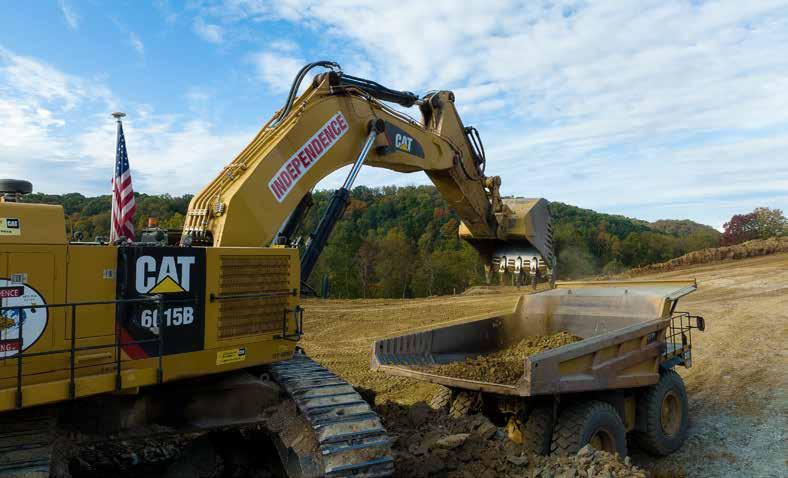
And choose a partner that knows how to help make it happen.
We o er customized options for commercial real estate owners and developers. We provide the attention, flexibility and expertise that only an independent bank can.
So, you can worry about breaking ground. Not cutting red tape.
John Casile
Senior Vice President
Jcasile418@dollarbank.com 412.261.8929
Becky Yago
Senior Vice President
Byago505@dollarbank.com 412.261.4288
Matt Bright Vice President
Mbright828@dollarbank.com 412.261.8959